This PDF is a selection from an out-of-print volume from the National
Bureau of Economic Research
Volume Title: Business Finance and Banking
Volume Author/Editor: Neil H. Jacoby and Raymond J. Saulnier
Volume Publisher: NBER
Volume ISBN: 0-870-14137-6
Volume URL: http://www.nber.org/books/jaco47-1
Publication Date: 1947
Chapter Title: Commercial Banks as Suppliers of Credit to Nonfinancial
Business: 1940
Chapter Author: Neil H. Jacoby, Raymond J. Saulnier
Chapter URL: http://www.nber.org/chapters/c4683
Chapter pages in book: (p. 38 - 68)

Chapter 2
.BANKS AS
SUPPLIERS OF CREDIT TO NONFINANCIAL
BUSINESS: 1940
IT IS USEFUL TO THINK of the American business credit market as
being composed of two divisions, one concerned with short-term
credit running for one year or less, and the other with medium-
term and long-term credit running more than one year to maturity.
The principal forms of short-term credit appearing on business
balance sheets are accounts payable and notes payable due in one
year or less, while the major forms of medium-term and long-
term credit are term loans due in more than one year, bonds, deben-
tures, and mortgage lOans. Each class of indebtedness represents
obligations due to a variety of creditors. In 1940 commercial banks
were an important source of medium- 'and long-term as well as of
short-term business credit, although they were not the ma] or source
of either type of credit.
SHORT-TERM VERSUS MEDIUM-TERM AND
LONG-TERM BUSINESS CREDIT
While the technical distinction between medium- and long-term
and short-term
is based upon the term to maturity of the
loan, one year being the dividing line, the true economic distinc-
tion is grounded on the nature of the business transaction being
financed. For example, businesses whose operations are subject to
strong seasonal influences are ordinarily large users of short-term
credit obtained to finance seasonal bulges in their operations. In
practice, however, there is no sharp divergence in the uses to which
either class of credit is put by business concerns. Loans that are
technically of short term may be used to finance fixed assets or long-
sustained operations, and medium- and long-term loans may be
used in part to finance temporary transactions.
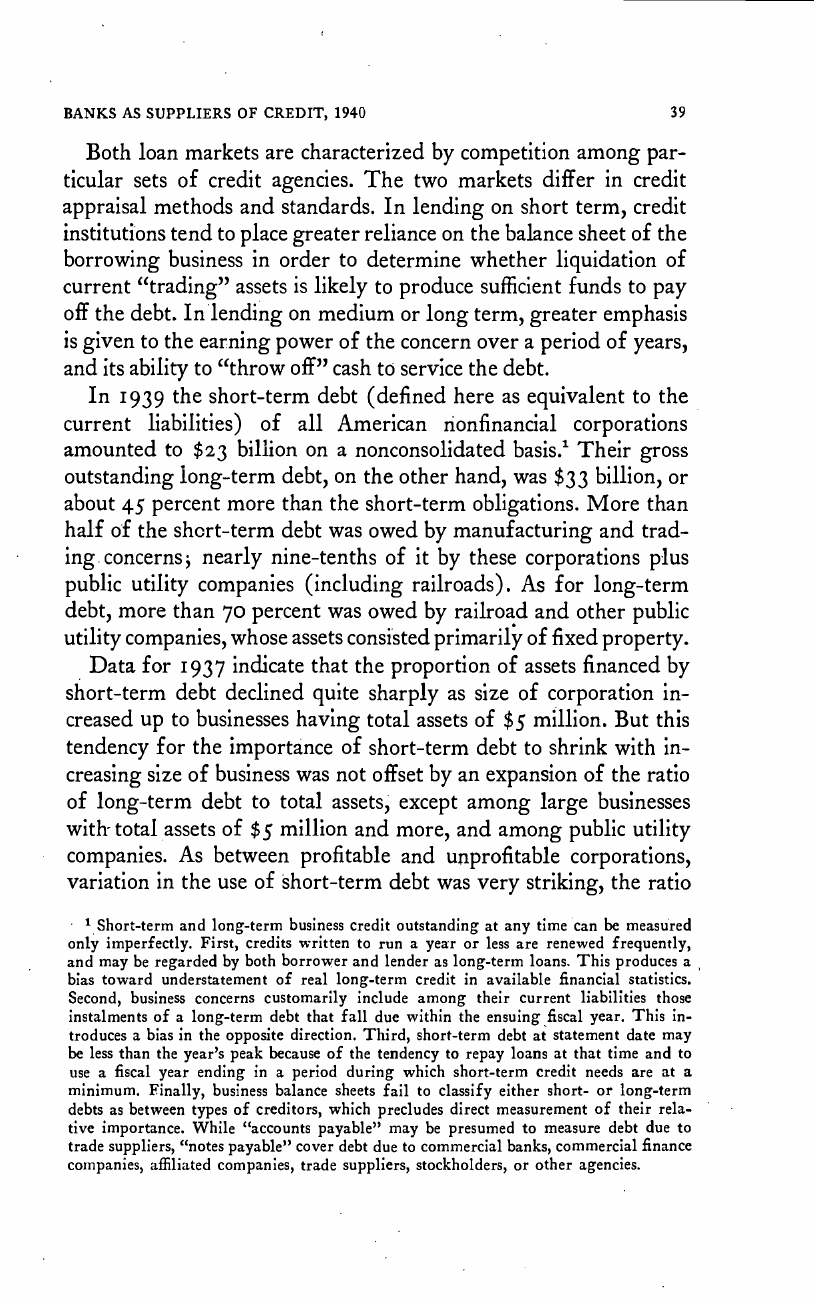
BANKS AS SUPPLIERS OF CREDIT, 1940
39
Both loan markets are characterized by competition among par-
ticular sets of credit agencies. The two markets differ in credit
appraisal methods and standards. In lending on short term, credit
institutions tend to place greater reliance on the balance sheet of the
borrowing business in order to determine whether liquidation of
current "trading" assets is likely to produce sufficient funds to pay
off the debt. In lending on medium or long term, greater emphasis
is given to the earning power of the concern over a period of years,
and its ability to "throw off" cash to service the debt.
In 1939 the short-term debt (defined here as equivalent to the
current
liabilities) of all American nonfinancial corporations
amounted to $23 billion on a nonconsolidated basis.1 Their gross
outstanding long-term debt, on the other hand, was
billion, or
about 45
percent more than the short-term obligations. More than
half of the short-term debt was owed by manufacturing and trad—
ing. concerns; nearly nine-tenths of it by these corporations plus
public utility companies (including railroads). As for long-term
debt, more than 70 percent was owed by railroad and other public
utility companies, whose assets consisted of fixed property.
Data for 1937 indicate that the proportion of assets financed by
short-term debt declined quite sharply as size of corporation in-
creased up to businesses having total assets of
million. But this
tendency for the importance of short-term debt to shrink with in-
creasing size of business was not offset by an expansion of the ratio
of long-term debt to total assets, except among large businesses
with total assets of $,ç million and more, and among public utility
companies. As between profitable and unprofitable corporations,
variation in the use of short-term debt was very striking, the ratio
•
' Short-term
and long-term business credit outstanding at any time can be measured
only imperfectly. First, credits written to run a year or less are renewed frequently,
and may be regarded by both borrower and lender as long-term loans. This produces a
bias toward understatement of real long-term credit in available financial statistics.
Second, business concerns customarily include among their current liabilities those
instalments of a long-term debt that fall due within the ensuing fiscal year. This in-
troduces a bias in the opposite direction. Third, short-term debt at statement date may
be less than the year's peak because of the tendency to repay loans at that time and to
use a fiscal year ending in a period during which short-term credit needs are at a
minimum. Finally, business balance sheets fail to classify either short- or long-term
debts as between types of creditors, which precludes direct measurement of their rela-
tive importance. While "accounts payable" may be presumed to measure debt due to
trade suppliers, "notes payable" cover debt due to commercial banks, commercial finance
companies, affiliated companies, trade suppliers, stockholders, or other agencies.
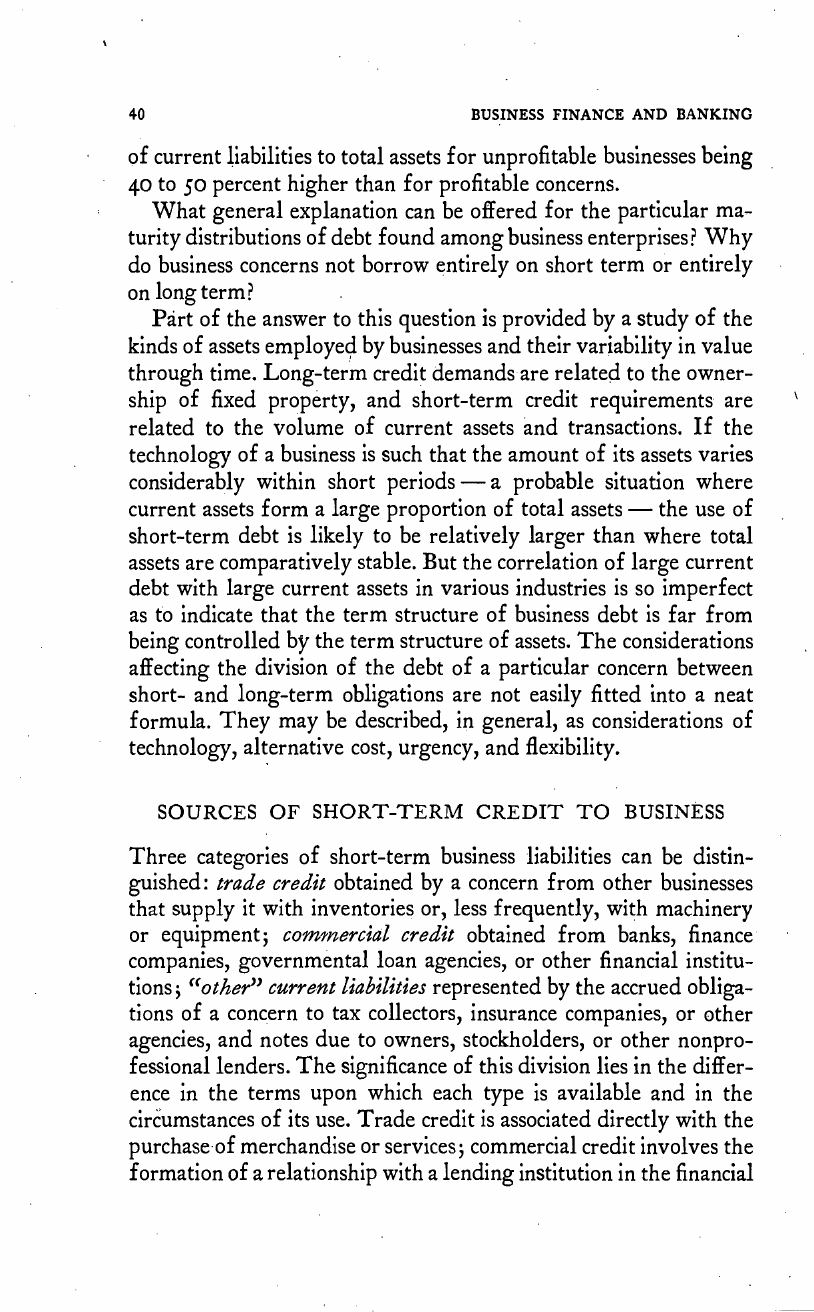
40 BUSINESS FINANCE AND BANKING
of current liabilities to total assets for unprofitable businesses being
40 to 50 percent higher than for profitable concerns.
What general explanation can be offered for the particular ma-
turity distributions of debt found among business enterprises? Why
do business concerns not borrow entirely on short term or entirely
on long term?
Part of the answer to this question is provided by a study of the
kinds of assets employed by businesses and their variability in value
through time. Long-term credit demands are related to the owner-
ship of fixed property, and short-term credit requirements are
related to the volume of current assets and transactions. If the
technology of a business is such that the amount of its assets varies
considerably within short periods —
a
probable situation where
current assets form a large proportion of total assets —
the
use of
short-term debt is likely to be relatively larger than where total
assets are comparatively stable. But the correlation of large current
debt with large current assets in various industries is so imperfect
as to
indicate that the term structure of business debt is far from
being controlled by the term structure of assets. The considerations
affecting the division of the debt of a particular concern between
short- and long-term obligations are not easily fitted into a neat
formula. They may be described, in general, as considerations of
technology, alternative cost, urgency, and flexibility.
SOURCES OF SHORT-TERM CREDIT TO BUSINESS
Three categories of short-term business liabilities can be distin-
guished: trade credit obtained by a concern from other businesses
that supply it with inventories or, less frequently, with machinery
or equipment; commercial credit obtained from banks, finance
companies, governmental loan agencies, or other financial institu-
tions; "other" current liabilities represented by the accrued obliga-
tions of a concern to tax collectors, insurance companies, or other
agencies, and notes due to owners, stockholders, or other nonpro-
fessional lenders. The significance of this division lies in the differ-
ence in the terms upon which each type is available and in the
circumstances of its use. Trade credit is associated directly with the
purchaseof merchandise or services; commercial credit involves the
formation of a relationship with a lending institution in the financial
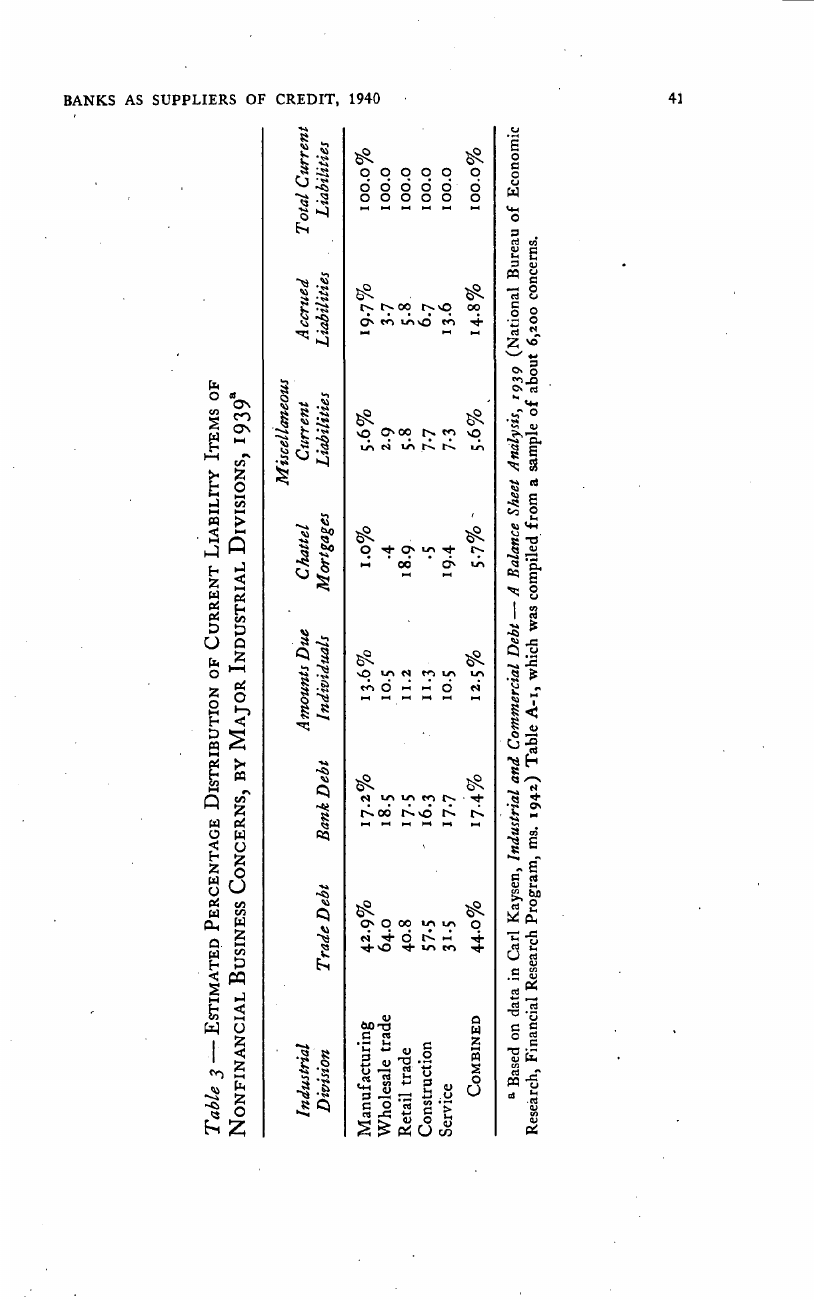
Industrial
Division
.
Trade Debt Bank Debt
Amounts Due
Individuals
.
Chattel
Mortgages
Miscellaneous
Current
Liabilities
A ccrued
Liabilities
Total Current
Liabilities
Manufacturing 42.9%
17.2%
13.6%
i.o%
'9.7%
ioo.o%
Wholesale trade 64.0
18.5 10.5
.4
2.9
3.7
100.0
Retail trade
40.8
17.5 11.2
100.0
Construction
57.5
- 16.3
11.3
.5
7.7
6.7
100.0
Service
31.5
17.7
10.5
59.4
7.3
13.6 100.0
COMBINED
44.0%
17.4%
5.7%
14.8%
a Based
on data in Carl Kaysen, Industrial and Commercial Debt —
A
Balance Sheet Analysis, 1939 (National Bureau of Economic
Research, Financial Research Program, ms. 1942)
Table
A-i, which was compiled from a sample of about 6,200 concerns.
C.)
'0
Table —
ESTIMATED PERCENTAGE DIs'riuBuTloN OF CURRENT LIABILITY ITEMS OF
NONFINANCIAL BUSINESS CONCERNS, BY MAJOR INDUSTRIAL DIvIsIoNs, 1939a
in
(I,
U,
'0
'0
t-.
in
In
0
"1
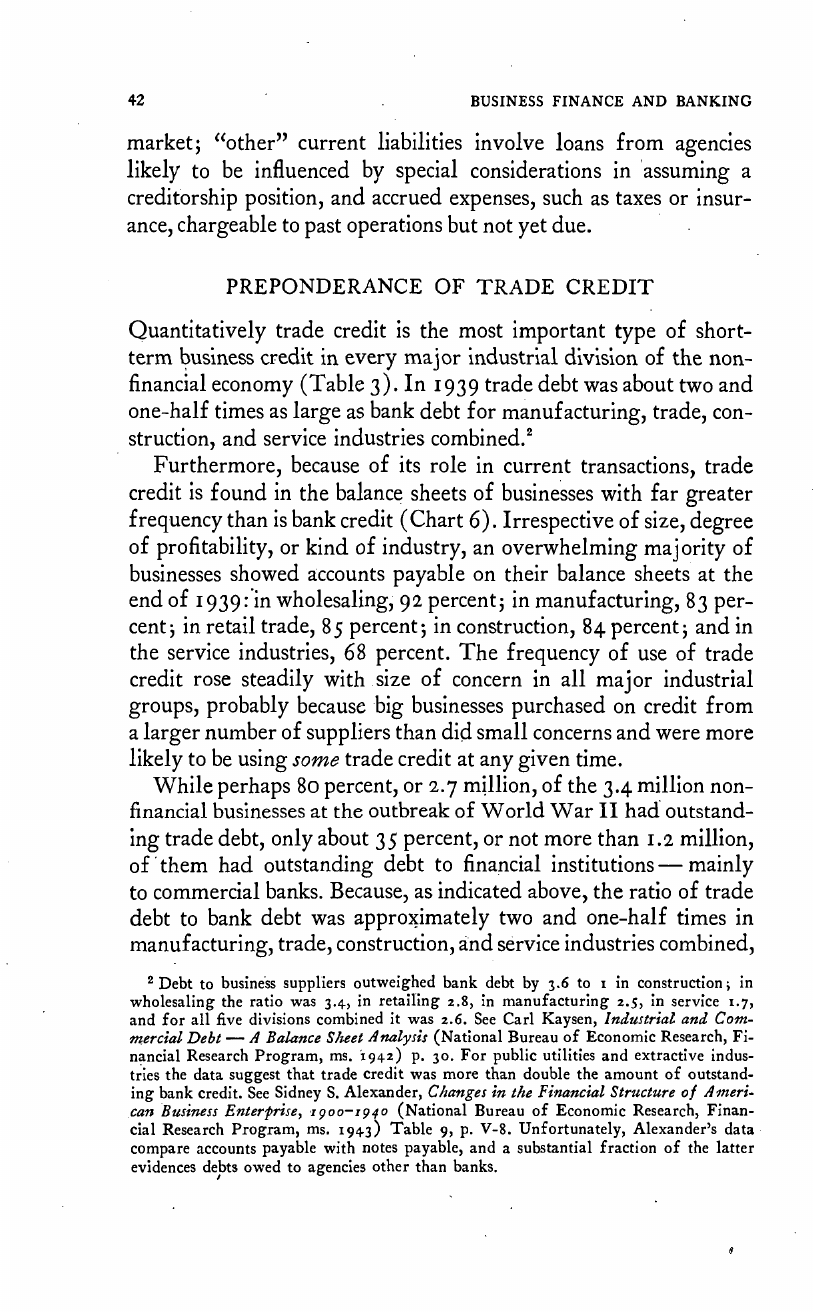
42
BUSINESS FINANCE AND BANKING
market; "other" current liabilities involve loans from agencies
likely to be influenced by special considerations in assuming a
creditorship position, and accrued expenses, such as taxes or insur-
ance, chargeable to past operations but not yet due.
PREPONDERANCE OF TRADE CREDIT
Quantitatively trade credit is the most important type of short-
term business credit in every major industrial division of the non—
financial economy (Table 3). In 1939 trade debt was about two and
one-half times as large as bank debt for manufacturing, trade, con-
struction, and service industries combined.2
Furthermore, because of its role in current transactions, trade
credit is found in the balance sheets of businesses with far greater
frequency than is bank credit (Chart 6). Irrespective of size, degree
of profitability, or kind of industry, an overwhelming majority of
businesses showed accounts payable on their balance sheets at the
end of 1939:in wholesaling, 92 percent; in manufacturing, 83 per-
cent; in retail trade,
percent; in construction, 84 percents and in
the service industries, 68 percent. The frequency of use of trade
credit rose steadily with size of concern in all ma] or industrial
groups, probably because big businesses purchased on credit from
a larger number of suppliers than did small concerns and were more
likely to be using some trade credit at any given time.
While perhaps 8o percent, or 2.7 million, of the 3.4 million non-
financial businesses at the outbreak of World War II had outstand-
ing trade debt, only about 35 percent, or not more than 1.2 million,
of them had outstanding debt to financial institutions — mainly
to commercial banks. Because, as indicated above, the ratio of trade
debt to bank debt was approrimately two and one-half times in
manufacturing, trade, construction, and service industries combined,
2
Debt to business
suppliers outweighed bank debt by 3.6 to
i in
construction; in
wholesaling the ratio was 3.4, in retaiitng z.S, in manufacturing in service 1.7,
and for all live divisions combined it was z.6. See Carl Kaysen, Industrial and
inerdal Debt — A
Balance Sheet Analysis (National Bureau of Economic Research, Fi-
nancial Research Program, ms. i942)
p.
30.
For public utilities and extractive indus-
tries the data suggest that trade credit was more than double the amount of outstand-
ing bank credit. See Sidney S. Alexander, Changes in the Financial Structure of
can Business Enterprise, 1900—1940 (National Bureau of Economic Research, Finan-
cial Research Program, ms. 1943) Table 9, p. V-S. Unfortunately, Alexander's data
compare accounts payable with notes payable, and a substantial fraction of the latter
evidences debts owed to agencies other than banks.
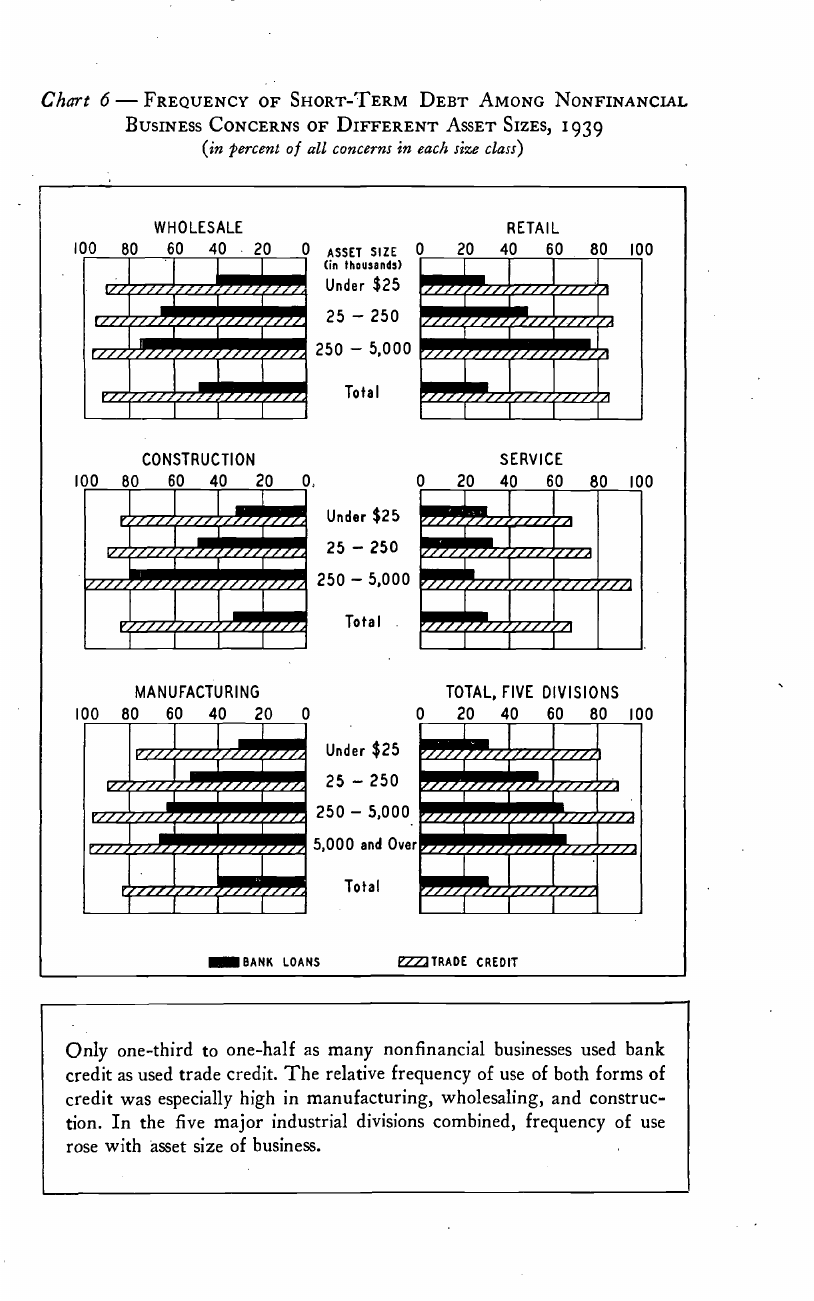
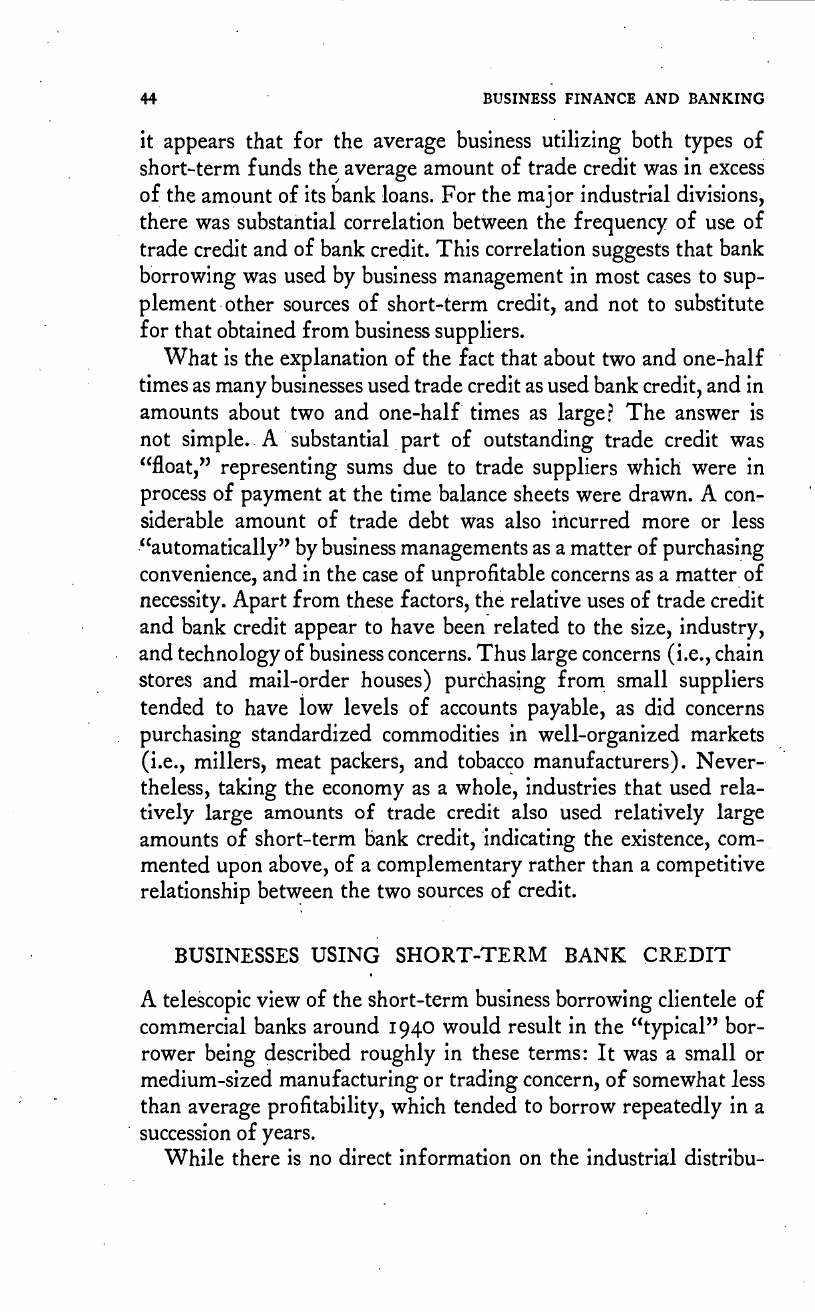
44
BUSINESS FINANCE AND BANKING
it appears that for the average business utilizing both types of
funds the average amount of trade credit was in excess
of the amount of its lank loans. For the major industrial divisions,
there was substantial correlation between the frequency of use of
trade credit and of bank credit. This correlation suggests that bank
borrowing was used by business management in most cases to sup-
plement . other
sources of short-term credit, and not to substitute
for that obtained from business suppliers.
What is the explanation of the fact that about two and one-half
times as many businesses used trade credit as used bank credit, and in
amounts about two and one-half times as large? The answer is
not simple.. A substantial
. part
of outstanding trade credit was
representing sums due to trade suppliers which were in
process of payment at the time balance sheets were drawn. A con-
siderable amount of trade debt was also incurred more or less
"automatically" by business managements as a matter of purchasing
convenience, and in the case of unprofitable concerns as a matter of
necessity. Apart from these factors, the relative uses of trade credit
and bank credit appear to have been related to the size, industry,
and technology of business concerns. Thus large concerns (i.e., chain
stores and mail-order houses) purchasing from small suppliers
tended to have low levels of accounts payable, as did concerns
purchasing standardized commodities in well-organized markets
(i.e., millers, meat packers, and tobacco manufacturers). Never-
theless, taking the economy as a whole, industries .that used rela-
tively large amounts of trade credit also used relatively large
amounts of short-term bank credit, indicating the existence, com-
mented upon above, of a complementary rather than a competitive
relationship between the two sources of credit.
BUSINESSES USING SHORT-TERM BANK CREDIT
A telescopic view of the short-term business borrowing clientele of
commercial banks around 1940 would result in the "typical" bor-
rower being described roughly in these terms: It was a small or
medium-sized manufacturing or trading concern, of somewhat less
than average profitability, which tended to borrow repeatedly in a
succession of years.
While there is no direct information on the industrial distribu-
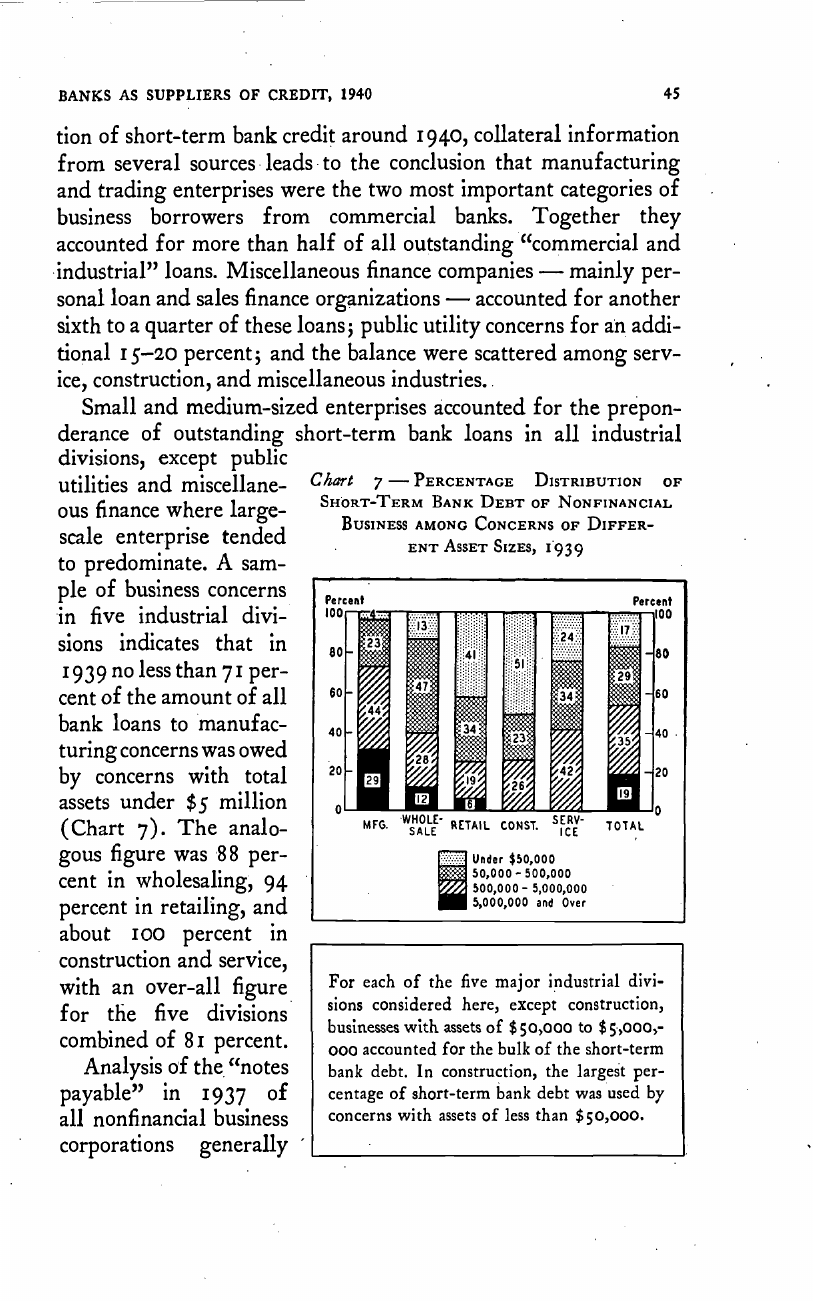
BANKS AS SUPPLIERS OF CREDIT, 1940
45
tion of short-term bank credit around 1940, collateral information
from several
leads• to the conclusion that manufacturing
and trading enterprises were the two most important categories of
business
borrowers from commercial
banks.
Together they
accounted for more than half of all outstanding "commercial and
industrial" loans. Miscellaneous finance companies — mainly per-
sonal loan and sales finance organizations —
accounted
for another
sixth to a quarter of these loans; public utility concerns for an addi-
tional i 5—so
percent;
and the balance were scattered among serv-
ice, construction, and miscellaneous industries..
Small and medium-sized enterprises accounted for the prepon-
derance of outstanding short-term bank loans in all industrial
divisions, except public
utilities and miscellane-
Chart
7
— PERCENTAGE
DISTRIBUTION
OF
ous finance where large-
SHORT-TERM BANIC DEBT OF NONFINANCIAL
BUSINESS AMONG CONCERNS OF DIFFER-
scale enterprise tended
. ENT ASSET SIZES, 1939
to predominate. A sam-
pie of business concerns
five industrial divi-
sions
indicates that
in
1939 no less than 71 per-
cent of the amount of all
bank loans to manufac-
turing concerns was owed
by concerns with total
assets under
million
(Chart 7). The analo—
gous figure was 88 per-
cent in wholesaling, 94
percent in retailing, and
about
100 percent in
________________________________
construction
and service,
with an over-all figure
For each of the five major industrial divi-
r p i. • . sions
considered here, except construction,
ior tne nve aivisions
bustuesses with assets of $50,000 to $ 5,000,-
combined of 81 percent.
000 accounted for the bulk of the short-term
Analysis of the. "notes
bank debt. In construction, the largest per-
payable"
in
1937
of
centage of short-term bank debt was used by
all nonfinancial business
concerns with assets of less than $50,000.
corporations generally
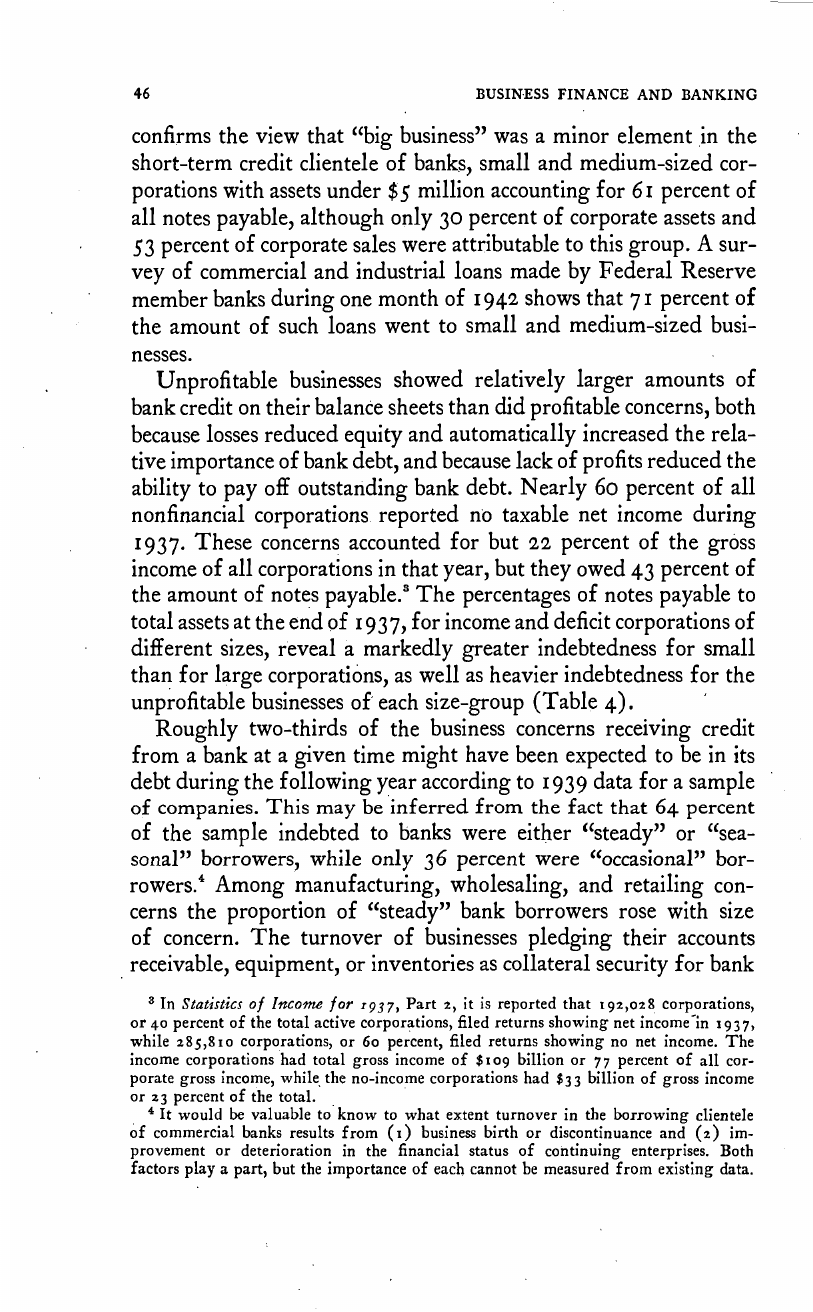
46
BUSINESS FINANCE AND BANKING
confirms the view that "big business" was a minor element in the
short-term credit clientele of banks, small and medium-sized cor-
porations with assets under $5
million accounting for 6i percent of
all notes payable, although oniy 30 percent of corporate assets and
53
percent
of corporate sales were attributable to this group. A sur-
vey of commercial and industrial loans made by Federal Reserve
member banks during one month of 1942 shows that 71 percent of
the amount of such loans went to small and medium-sized busi-
nesses.
Unprofitable businesses showed relatively larger amounts of
bank credit on their balance sheets than did profitable concerns, both
because losses reduced equity and automatically increased the rela-
tive importance of bank debt, and because lack of profits reduced the
ability to pay off outstanding bank debt. Nearly 6o percent of all
nonfinancial corporations. reported no taxable net income during
1937. These concerns accounted for but 22 percent of the gross
income of all corporations in that year, but they owed 43 percent of
the amount of notes payable.8 The percentages of notes payable to
total assets at the end of 1937, for income and deficit corporations of
different sizes, reveal a markedly greater indebtedness for small
than for large corporations, as well as heavier indebtedness for the
unprofitable businesses of each size-group (Table 4).
Roughly two-thirds of the business concerns receiving credit
from a bank at a given time might have been expected to be in its
debt during the following year according to 1939 data for a sample
of companies. This may be inferred from the fact that 64 percent
of the sample indebted to banks were either "steady" or "sea-
sonal" borrowers, while only 36 percent were bor-
rowers.4 Among manufacturing, wholesaling, and retailing con-
cerns the proportion of "steady" bank borrowers rose with size
of concern. The turnover of businesses pledging their accounts
receivable, equipment, or inventories as collateral security for bank
In Statistics of Income for '937, Part it is reported that 192,028 corporations,
or 40 percent of the total active corporations, filed returns showing net incomeln 1937,
while z8g,Sio corporations, or 6o percent, filed returns showing no net income. The
income corporations had total gross income of $109 billion or 77 percent of all cor-
porate gross income, while the no-income corporations had $33 billion of gross income
or 23
percent of the total.
It would be valuable to know to what
turnover in the borrowing clientele
of commercial banks results from (z) business birth or discontinuance and (z) im-
provement or deterioration in the financial status of continuing enterprises. Both
factors play a part, but the importance of each cannot be measured from existing data.
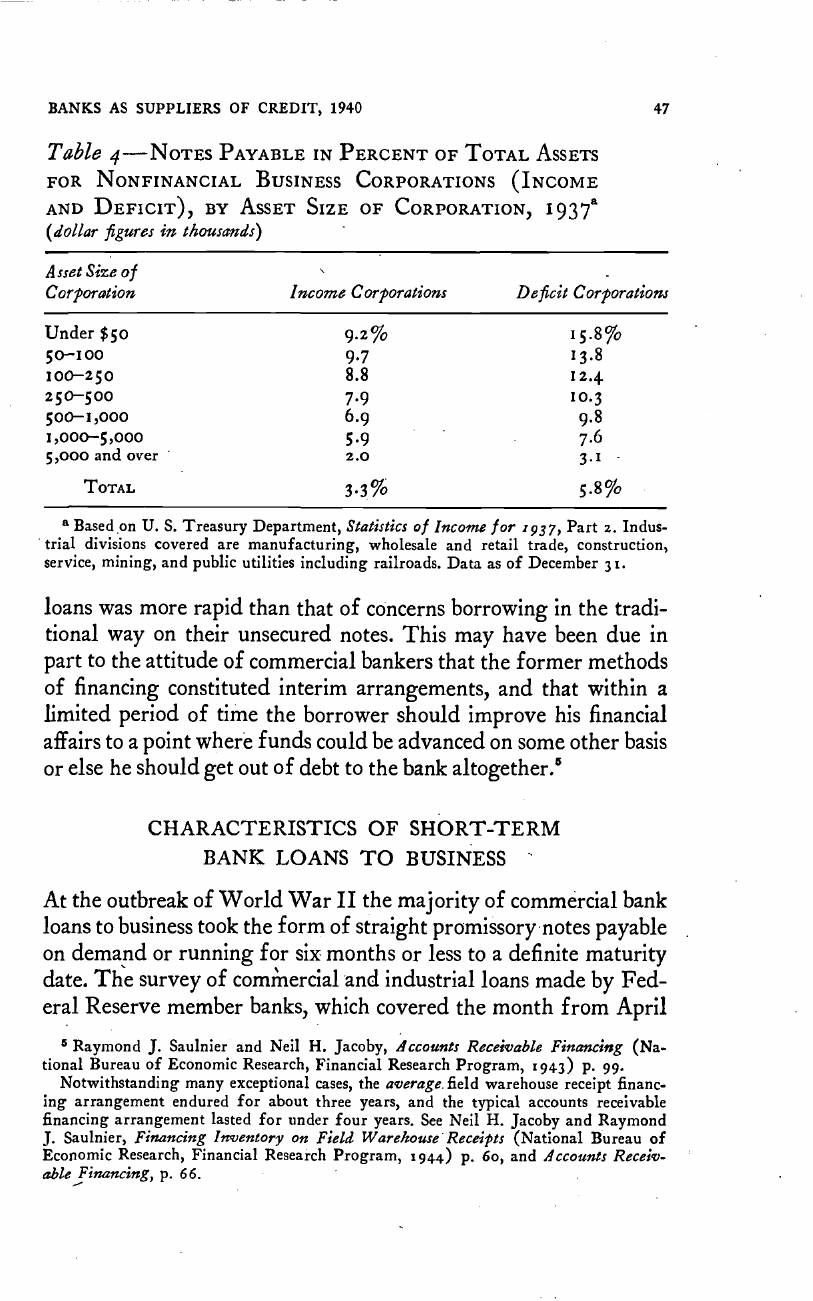
BANKS AS SUPPLIERS OF CREDIT, 1940
47
Table 4—NOTES PAYABLE IN PERCENT OF TOTAL ASSETS
FOR NONFINANCIAL BUSINESS CORPORATIONS (INcoME
DEFICIT), BY ASSET SIZE OF CORPORATION,
(dollar
figures in thousands)
Asset Size of
Corporation Income Corporations Deficit Corpora/ions
Under 9.2%
50—100
9.7
13.8
100—250
8.8 12.4
250—500
7.9
10.3
6.9
9.8
1,000-5,000
5.9 .
. 7.6
5,000 and over
2.0
3.1 -
TOTAL
3.3%
a Based
on U. S. Treasury Department, Statistics of Income for 1937,
Part
z. Indus-
trial divisions covered are manufacturing, wholesale and retail trade, construction,
service, mining, and public utilities including railroads. Data as of December 31.
loans was more rapid than that of concerns borrowing in the tradi-
tional way on their unsecured notes. This may have been due in
part to the attitude of commercial bankers that the former methods
of financing constituted interim arrangements, and that within a
limited period of time the borrower should improve his financial
affairs to a point where funds could be advanced on some other basis
or else he should get out of debt to the bank altogether.5
CHARACTERISTICS OF SHORT-TERM
BANK LOANS TO BUSINESS
At the outbreak of World War lithe majority of commercial bank
loans to business took the form of straight promissory-notes payable
on demand or running for six months or less to a definite maturity
date. The survey of comr'nercial and industrial loans made by Fed-
eral Reserve member banks, which covered the month from April
Raymond J. Saulnier and Neil H. Jacoby, Accounts Receivable Financing (Na-
tional Bureau of Economic Research, Financial Research Program, 1943) p. 99.
Notwithstanding many exceptional cases, the average, field warehouse receipt financ-
ing arrangement endured for about three years, and the typical accounts receivable
financing arrangement lasted for under four years. See Neil H. Jacoby and Raymond
J. Saulnier, Financing Inven€ory on Field Warehouse 'Receipts (National Bureau of
Economic Research, Financial Research Program, 1944) p. 6o, and ..4ccounts Receiv-
able Fimzncing, p. 66.
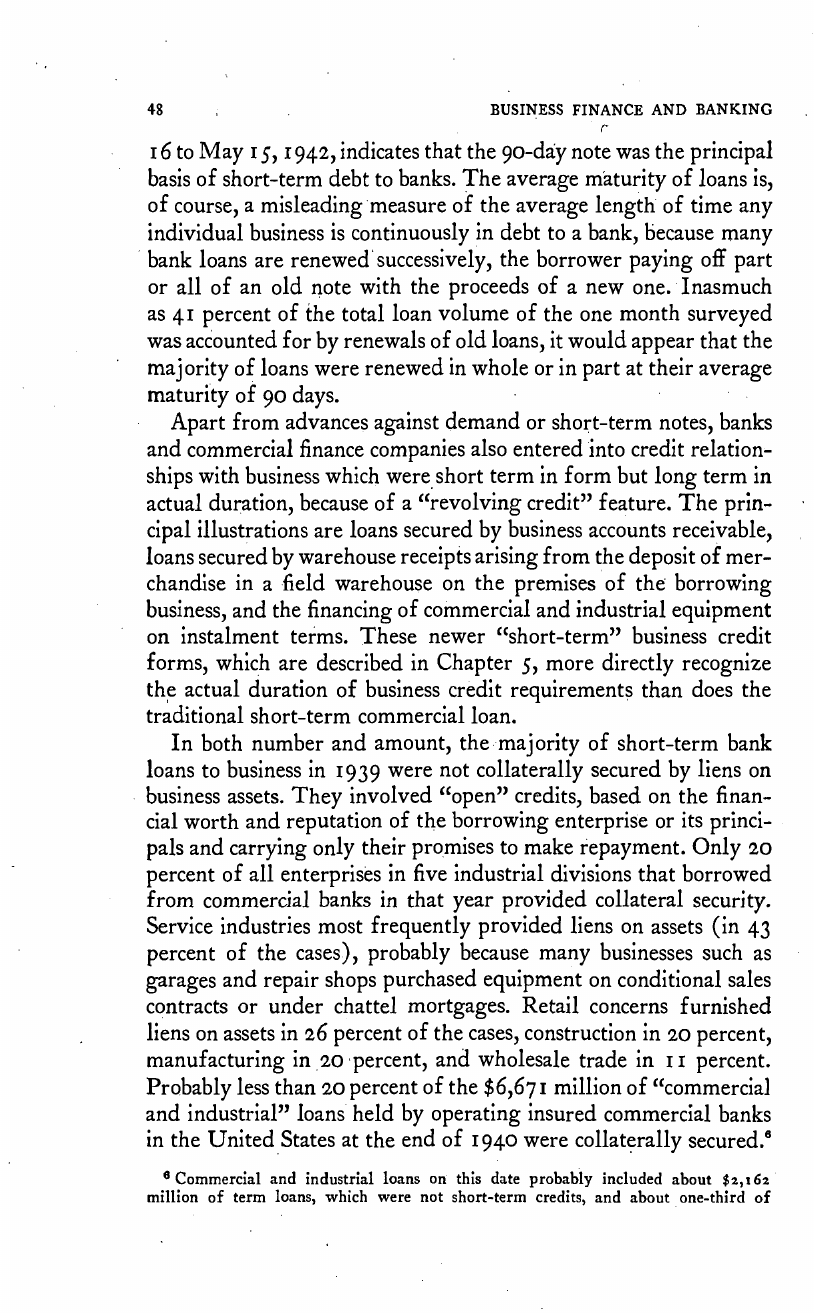
48 BUSINESS FINANCE AND BANKING
r 6 to May 15, 1942, indicates that the 90-day note was the principal
basis of short-term debt to banks. The average maturity of loans is,
of course, a misleading measure of the average length of time any
individual business is continuously in debt to a bank, because many
bank loans are renewed successively, the borrower paying off part
or all of an old note with the proceeds of a new one. Inasmuch
as 41 percent of the total loan volume of the one month surveyed
was accounted for by renewals of old loans, it would appear that the
majority of loans were renewed in whole or in part at their average
maturity of 90 days.
Apart from advances against demand or short-term notes, banks
and commercial finance companies also entered into credit relation-
ships with business which were short term in form but long term in
actual duration, because of a "revolving credit" feature. The prin-
cipal illustrations are loans secured by business accounts receivable,
loans secured by warehouse receipts arising from the deposit of mer-
chandise in a field warehouse on the premises of the borrowing
business, and the financing of commercial and industrial equipment
on instalment terms. These newer "short-term" business credit
forms, which are described in Chapter 5, more directly recognize
the actual duration of business credit requirements than does the
traditional short-term commercial loan.
In both number and amount,
of short-term bank
loans to business in 1939 were not collaterally secured by liens on
business assets. They involved "open" credits, based on the finan-
cial worth and reputation of the borrowing enterprise or its princi-
pals and carrying only their promises to make repayment. Only 20
percent of all enterprises in five industrial divisions that borrowed
from commercial banks in that year provided collateral security.
Service industries most frequently provided liens on assets (in 43
percent of the cases), probably because many businesses such as
garages and repair shops purchased equipment on conditional sales
contracts or under chattel mortgages. Retail concerns furnished
liens on assets in 26 percent of the cases, construction in 2o percent,
manufacturing in 20 percent, and wholesale trade in ii percent.
Probably less than 20 percent of the $6,671 million of "commercial
and industrial" loans held by operating insured commercial banks
in the United States at the end of 1940 were collaterally secured.6
Commercial and industrial loans on this date probably included about $2,162•
million of term loans, which were not short-term credits, and about one-third of
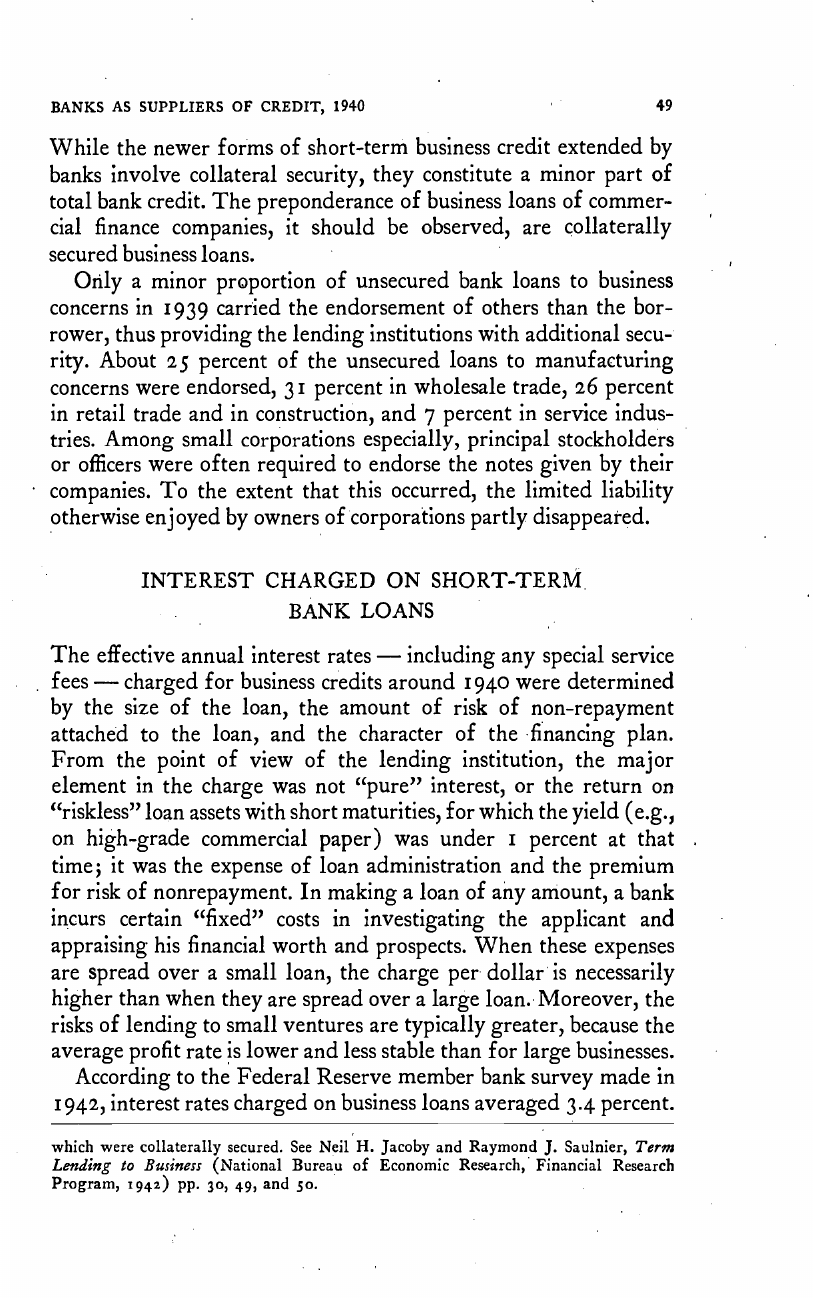
BANKS AS SUPPLIERS OF CREDIT, 1940
49
While the newer forms of short-term business credit extended by
banks involve collateral security, they constitute a minor part of
total bank credit. The preponderance of business loans of commer-
cial finance companies, it should be observed, are collaterally
secured business loans.
Only a minor proportion of unsecured bank loans to business
concerns in 1939 carried the endorsement of others than the bor-
rower, thus providing the lending institutions with additional secu-
rity. About percent of the unsecured loans to manufacturing
concerns were endorsed, 31 percent in wholesale trade, 26 percent
in retail trade and in construction, and 7 percent in service indus-
tries. Among small corporations especially, principal stockholders
or officers were often required to endorse the notes given by their
companies. To the extent that this occurred, the limited liability
otherwise enjoyed by owners of corporations partly disappeared.
INTEREST CHARGED ON SHORT-TERM.
BANK LOANS
The effective annual interest rates — including any special service
fees —
charged for business credits around 1940 were determined
by the size of the loan, the amount of risk of non-repayment
attached to the loan, and the character of the financing plan.
From the point of view of the lending institution, the major
element in the charge was not "pure" interest, or the return on
loan assets with short maturities, for which the yield (e.g.,
on high-grade commercial paper) was under i percent at that
time; it was the expense of loan administration and the premium
for risk of nonrepayment. In making a loan of any amount, a bank
incurs certain "fixed" costs in investigating the applicant and
appraising his financial worth and prospects. When these expenses
are spread over a small loan, the charge per dollar' is necessarily
higher than when they are spread over a large loan. Moreover, the
risks of lending to small ventures are typically greater, because the
average profit rate is lower and less stable than for large businesses.
According to the Federal Reserve member bank survey made in
1942, interest rates charged on business loans averaged 3.4 percent.
which were collaterally secured. See Neil H. Jacoby and Raymond J. Saulnier, Term
Lending to Business (National Bureau of Economic Research, Financial Research
Program, 1942) pp. 3o,
and
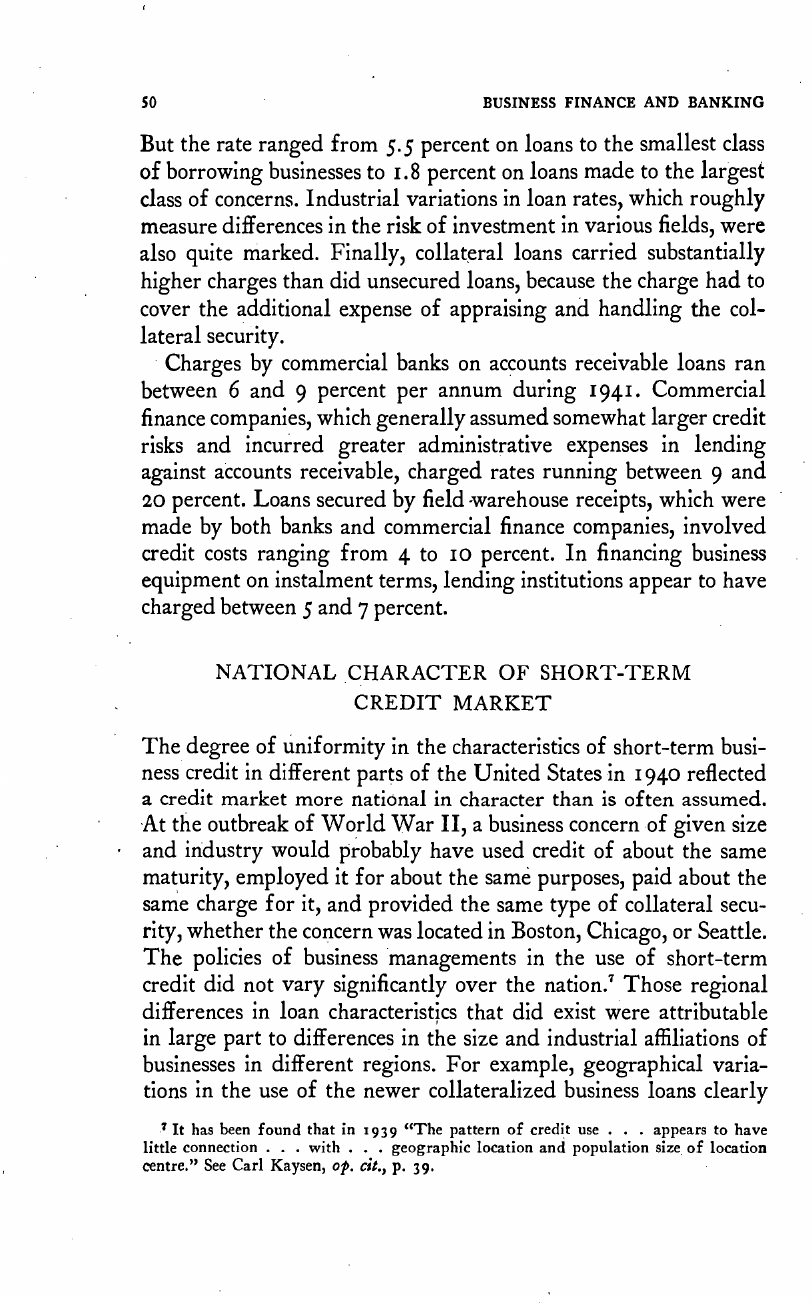
SO
BUSINESS FINANCE AND BANKING
But the rate ranged from percent on loans to the smallest class
of borrowing businesses to 1.8 percent
on loans made to the largest
dass of concerns. Industrial variations in loan rates, which roughly
measure differences in the risk of investment in various fields, were
also quite marked. Finally, collateral loans carried substantially
higher charges than did unsecured loans, because the charge had to
cover the additional expense of appraising and handling the col-
lateral security.
Charges by commercial banks on accounts receivable loans ran
between 6 and 9 percent per annum during 1941. Commercial
finance companies, which generally assumed somewhat larger credit
risks and incurred greater administrative expenses in lending
against accounts receivable, charged rates running between 9 and
20 percent. Loans secured by field -warehouse receipts, which were
made by both banks and commercial finance companies, involved
credit costs ranging from 4 to 10 percent. In financing business
equipment on instalment terms, lending institutions appear to have
charged between 5 and 7 percent.
NATIONAL CHARACTER OF SHORT-TERM
CREDIT MARKET
The degree of uniformity in the characteristics of short-term busi-
ness credit in different parts of the United States in 1940 reflected
a credit market more national in character than is often assumed.
At the outbreak of World War II, a business concern of given size
and industry would probably have used credit of about the same
maturity, employed it for about the same purposes, paid about the
same charge for it, and provided the same type of collateral secu-
rity, whether the concern was located in Boston, Chicago, or Seattle.
The policies of business managements in the use of short-term
credit did not vary significantly over the nation.7 Those regional
differences in loan characteristics that did exist were attributable
in large part to differences in the size and industrial affiliations of
businesses in different regions. For example, geographical varia-
tions in the use of the newer collateralized business loans clearly
It has been found that in 1939 "The pattern of credit use
.
appears to have
little connection
with .
. geographic location and population size of location
centre." See Carl Kaysen,
cit., p.
39.
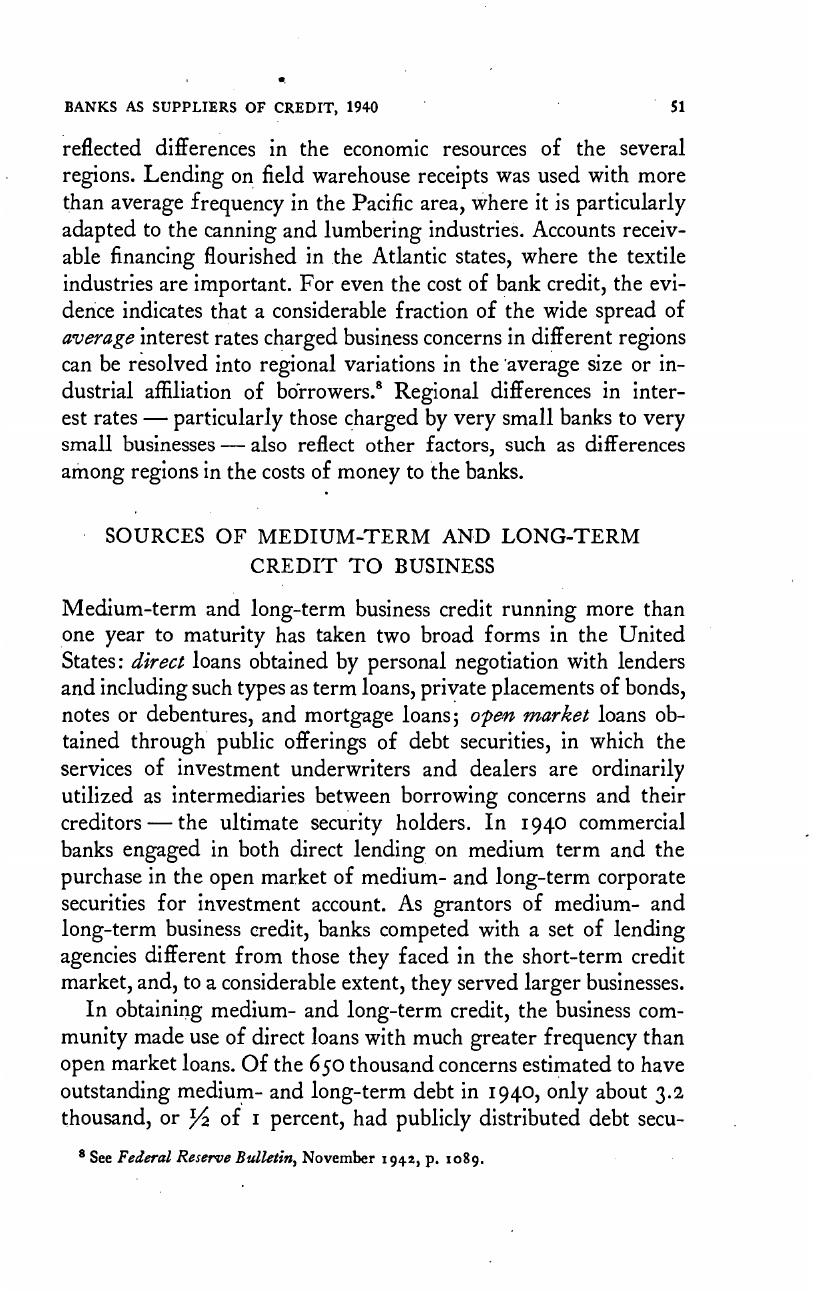
BANKS AS SUPPLIERS OF CREDIT, 1940
51
reflected differences in the economic resources of the several
regions. Lending on field warehouse receipts was used with more
than average frequency in the Pacific area, where it is particularly
adapted to the canning and lumbering industries. Accounts receiv-
able financing flourished in the Atlantic states, where the textile
industries are important. For even the cost of bank credit, the evi-
dence indicates that a considerable fraction of the wide spread of
average interest rates charged business concerns in different regions
can be resolved into regional variations in the
size or in-
dustrial affiliation of borrowers.8 Regional differences in inter-
est rates — particularly
those charged by very small banks to very
small businesses
also
reflect other factors, such as differences
among regions in the costs of money to the banks.
SOURCES OF MEDIUM-TERM AND LONG-TERM
CREDIT TO BUSINESS
Medium-term and long-term business credit running more than
one year to maturity has taken two broad forms in the United
States: direct loans obtained by personal negotiation with lenders
and including such types as term loans, priyate placements of bonds,
notes or debentures, and mortgage loans;
market
loans ob-
tained through public offerings of debt securities, in which the
services of investment underwriters and dealers are ordinarily
utilized as intermediaries between borrowing concerns and their
creditors —
the
ultimate security holders. In 1940 commercial
banks engaged in both direct lending on medium term and the
purchas.e in the open market of medium- and long-term corporate
securities for investment account. As grantors of medium- and
long-term business credit, banks competed with a set of lending
agencies different from those they faced in the short-term credit
market, and, to a considerable extent, they served larger businesses.
In obtaining medium- and long-term credit, the business com-
munity made use of direct loans with much greater frequency than
open market loans. Of the 650 thousand concerns estimated to have
outstanding medium- and long-term debt in 1940, only about 3.2
thousand, or 3/2 of i percent, had publicly distributed debt secu-
See Federal
Reserve Bulletin, November 1942,
p. IoS9.
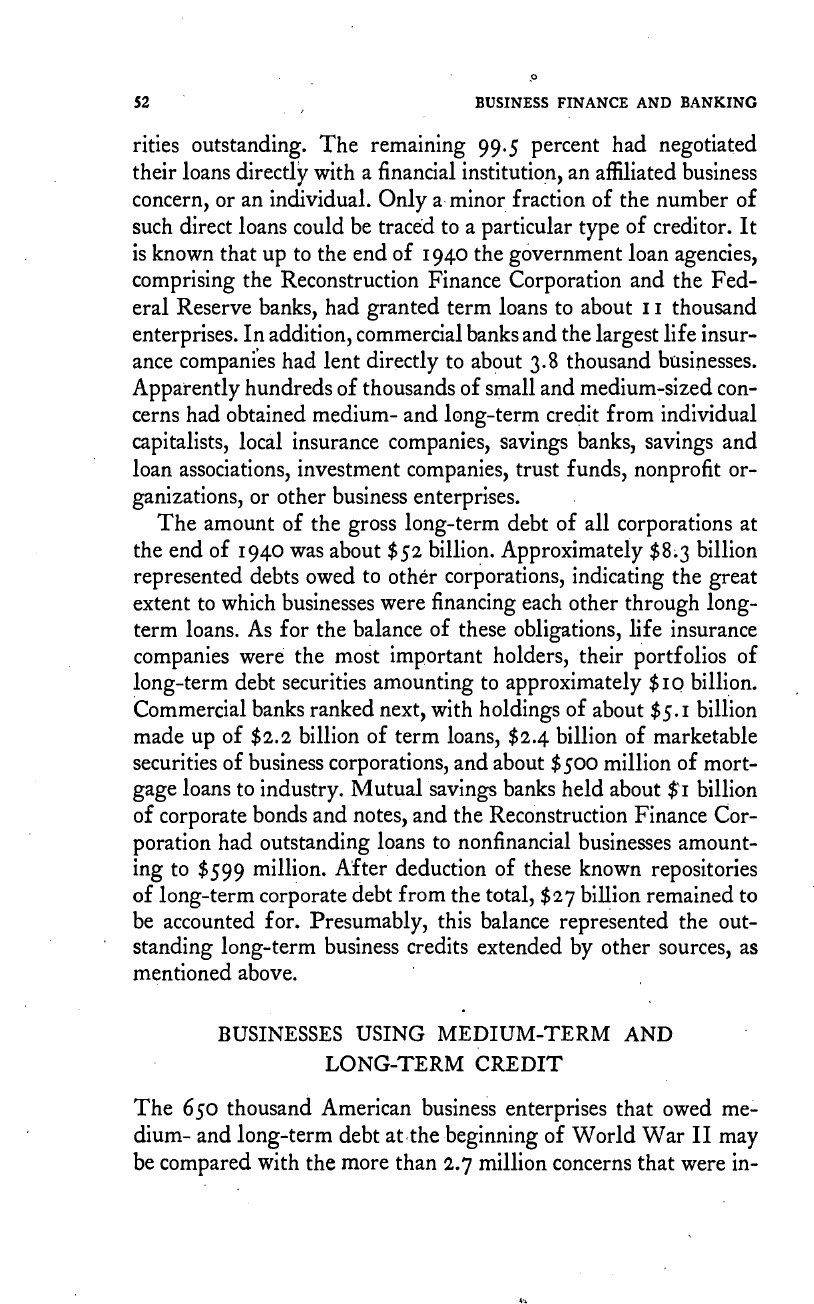
0
52
BUSINESS FINANCE AND BANKING
rities outstanding. The remaining 99.5 percent had negotiated
their loans directly with a financial institution, an affiliated business
concern, or an individual. Only a minor fraction of the number of
such direct loans could be traced to a particular type of creditor. It
is known that up to the end of 1940 the government loan agencies,
comprising the Reconstruction Finance Corporation and the Fed-
eral Reserve banks, had granted term loans to about i i thousand
enterprises. In addition, commercial banks and the largest life insur-
ance
had lent directly to about 3.8 thousand businesses.
Apparently hundreds of thousands of small and medium-sized con-
cerns had obtained medium- and long-term cre4it from individual
capitalists, local insurance companies, savings banks, savings and
loan associations, investment companies, trust funds, nonprofit or-
ganizations, or other business enterprises.
The amount of the gross long-term debt of all corporations at
the end of 1940 was about $52 billion. Approximately $83 billion
represented debts owed to other corporations, indicating the great
extent to which businesses were financing each other through long-
term loans. As for the balance of these obligations, life insurance
companies were the most important holders, their portfolios of
long-term debt securities amounting to approximately $io billion.
Commercial banks ranked next, with holdings of about $.g.i billion
made up of $2.2 billion of term loans, $2.4 billion
of marketable
securities of business corporations, and about $çoo million of mort-
gage loans to industry. Mutual savings banks held about $'i billion
of corp orate bonds and notes, and the Reconstruction Finance Cor-
poration had outstanding loans to nonfinancial businesses amount-
ing to $599 million.
After deduction of these known repositories
of long-term corporate debt from the total, $27 billion remained to
be accounted for. Presumably, this balance represented the out-
standing long-term business credits extended by other sources, as
mentioned above.
BUSINESSES USING MEDIUM-TERM AND
LONG-TERM CREDIT
The 65o thousand American business enterprises that owed me-
dium- and long-term debt at the beginning of World War II may
be compared with the more than
million concerns that were in-
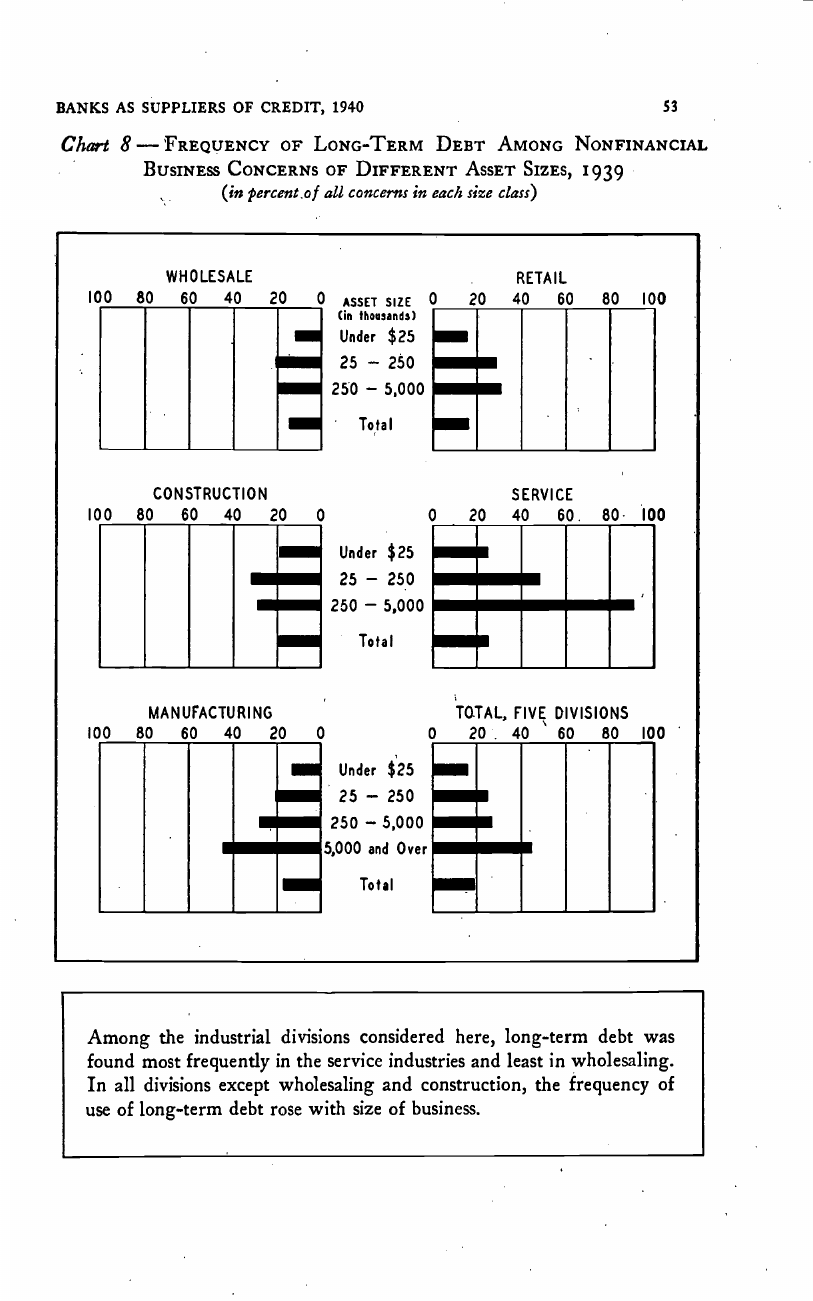
BANKS AS SUPPLIERS OF CREDIT, 1940
53
Chart 8 — FREQUENCY
OF LONG-TERM DEBT AMONG
BUSINESS CONCERNS OF DIFFERENT ASSET SIZES,
(in percent of all concerns in each size class)
NON F! NAN CML
'939
WHOLESALE
100
80 60 40
20
0
ASSET SIZE
(in thousands)
Under $25
25 — 250
250 — 5,000
RETAIL
20
40
60
CONSTRUCTION
100
80
60
40
—
.
I
.
I
0 80 100
. -.
—
To,t a I
SE RV I CE
0 20
40 60. 80• 100
Under
25 —
250 —
$25
250
5,000
_____ _____ _____
20
0
MANUFACTURING
100
80 60 40
20 0
I
—,
I
FIVE
0
20. 40
Total
Under $25
25 — 250
250 —
5,000 and Over
Total
DIV IS IONS
60
80 00
—
.
. U
Among the industrial divisions considered here, long-term debt was
found most frequently in the service industries and least in wholesaling.
In all divisions except wholesaling and construction, the frequency of
use of long-term debt rose with size of business.
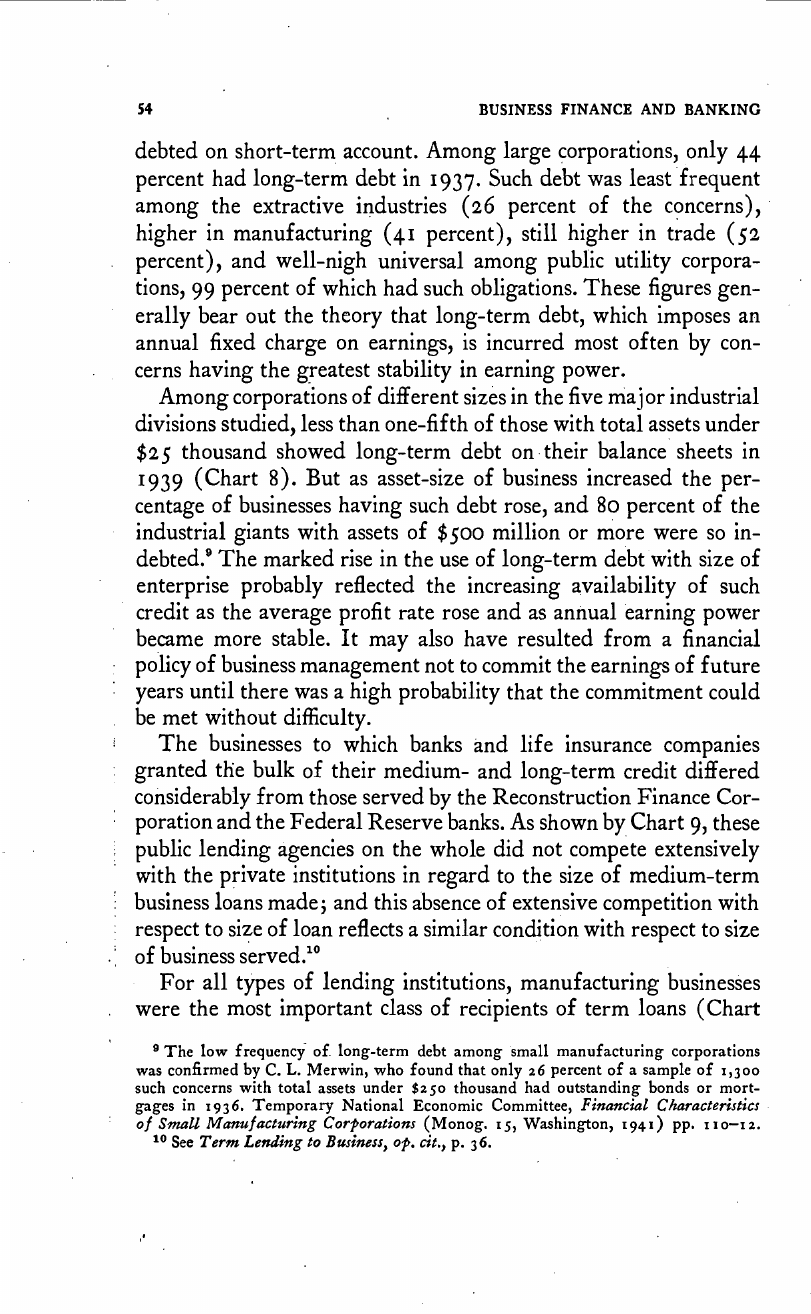
54 BUSINESS FINANCE AND BANKING
debted on short-term account. Among large corporations, only 44
percent had long-term debt in 1937. Such debt was least frequent
among the extractive industries (26 percent of the concerns),
higher in manufacturing percent), still higher in trade
• percent), and well-nigh universal among public utility corpora-
tions, 99 percent of which had such obligations. These figures gen-
•
erally bear out the theory that long-term debt, which imposes an
annual fixed charge on earnings, is incurred most often by con-
cerns having the greatest stability in earning power.
Among corporations of different sizes in the five ma] or industrial
divisions studied, less than one-fifth of those with total assets under
$25 thousand showed long-term debt on their balance sheets in
1939 (Chart 8). But as asset-size of business increased the per-
centage of businesses having such debt rose, and 8o percent of the
• industrial giants with assets of $çoo million or more were so in-
debted.9 The marked rise in the use of long-term debt with size of
enterprise probably reflected the increasing availability of such
credit as the average profit rate rose and as annual earning power
became more stable. It may also have resulted from a financial
policy of business management not to commit the earnings of future
years until there was a high probability that the commitment could
•
be met without difficulty.
The businesses to which banks and life insurance companies
granted the bulk of their medium- and long-term credit differed
considerably from those served by the Reconstruction Finance Cor-
•
poration and the Federal Reserve banks. As shown by Chart 9, these
public lending agencies on the whole did not compete extensively
with the private institutions in regard to the size of medium-term
business loans made; and this absence of extensive competition with
respect to size of loan reflects a similar condition with respect to size
of business served.'°
For all types of lending institutions, manufacturing businesses
were the most important class of recipients of term loans (Chart
The low frequency of. long-term debt among small manufacturing corporations
was confirmed by C. L. Merwin, who found that only 26 percent of a sample of 1,300
such concerns with total assets under $z5o thousand had outstanding bonds or mort-
gages in 1936. Temporary
National Economic Committee,
Characteristics
of Small Manufacturing Corporations (Monog. 15, Washington, 194 i) pp. iio—iz.
10 See Term Lending to Business, op. Cit., p. 36.
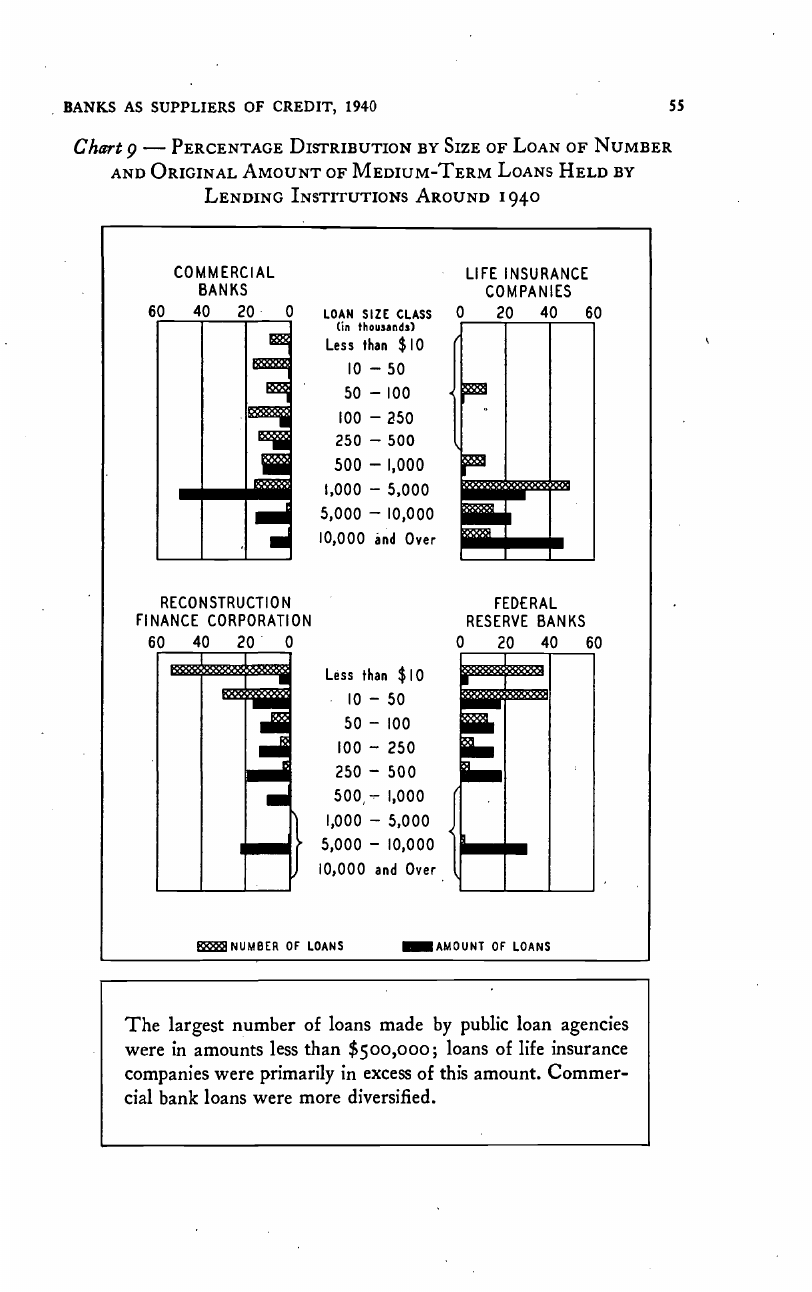
BANKS AS SUPPLIERS OF CREDIT, 1940
55
C
hart ç
— PERCENTAGE
DISTRIBUTION BY SIZE OF LOAN OF NUMBER
AND ORIGINAL AMOUNT OF MEDIUM-TERM LOANS HELD BY
LENDING INSTITUTIONS AROUND 1940
COMMERCIAL
BANKS
60
40
20 0
LOAN SIZE CLASS
0
(in thousands)
Less than $10
10 — 50
50 — 100
100 — 250
250 — 500
500 — 1,000
1,000 — 5,000
5,000 — 10,000
10,000 and Over
LIFE INSURANCE
COMPANIES
20
40
60
Less than
10 —
50 —
too —
250 —
500,—
1,000 —
5,000 —
10,000
OF LOANS
____
AMOUNT OF LOANS
RECONSTRUCTION
FEDERAL
FINANCE CORPORATION
RESERVE
BANKS
60
40
20 0
0 20
40
60
$10
50
100
250
500
1,000
5,000
10,000
and Over
I__—
The largest number of loans made by public loan agencies
were in amounts less than $500,000; loans of life insurance
companies were primarily in excess of this amount. Commer-
cial bank loans were more diversified.
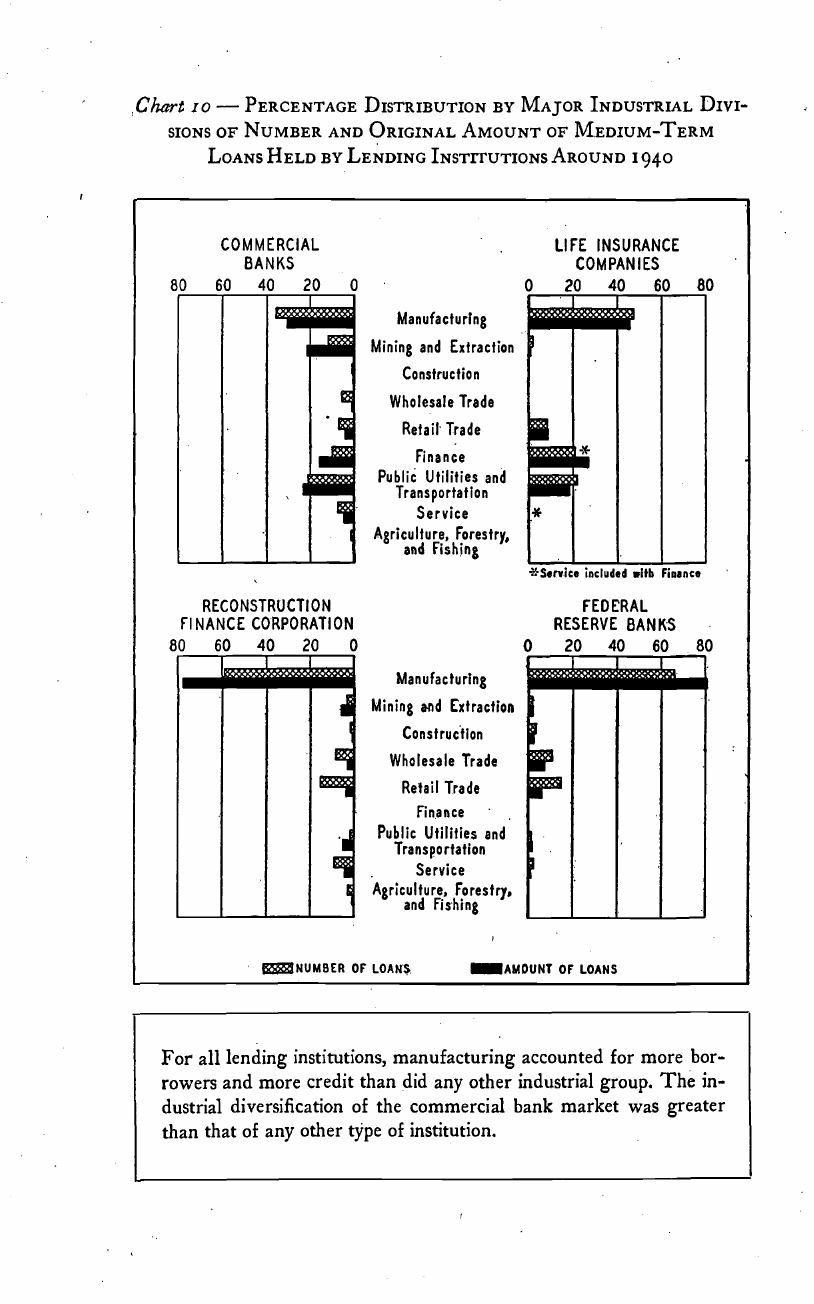
Chart io — PERCENTAGE
DIsnUBUTI0N BY MAJOR INDUSTRIAL Divi-
SIONS OF NUMBER AND ORIGINAL AMOUNT OF MEDIUM-TERM
LOANS HELD BY LENDING INSTiTUTIONS AROUND 1940
COMMERCIAL
LIFE INSURANCE
BANKS
COMPANIES
80 60
40
20 0
0 20
40
60
80
Manufacturing
I
Minng and Extraction
Construction
Wholesale Trade
Retail Trade
_____
Finance
Public Utilities and
•
Transportation
Service
I
Agriculture, Forestry.
and Fishing
RECONSTRUCTION
FINANCE CORPORATION
80 60
40
20 0
0
Manufacturing
Mining and Extraction
I
Construclion
•
Wholesale Trade
Retail Trade
Finance
Public Utilities and
Transportation
Service
Agriculture, Forestry.
—
_____ _____
and Fishing
•
OF LOANS
_I
*
included aith Finance
FEDERAL
RESERVE BANKS
20
40
60
80
I
AMOUNT OF LOANS
For
all lending institutions, manufacturing accounted for more bor-
rowers and more credit than did any other industrial group. The in-
dustrial diversification of the commercial bank market was greater
than that of any other type of institution.
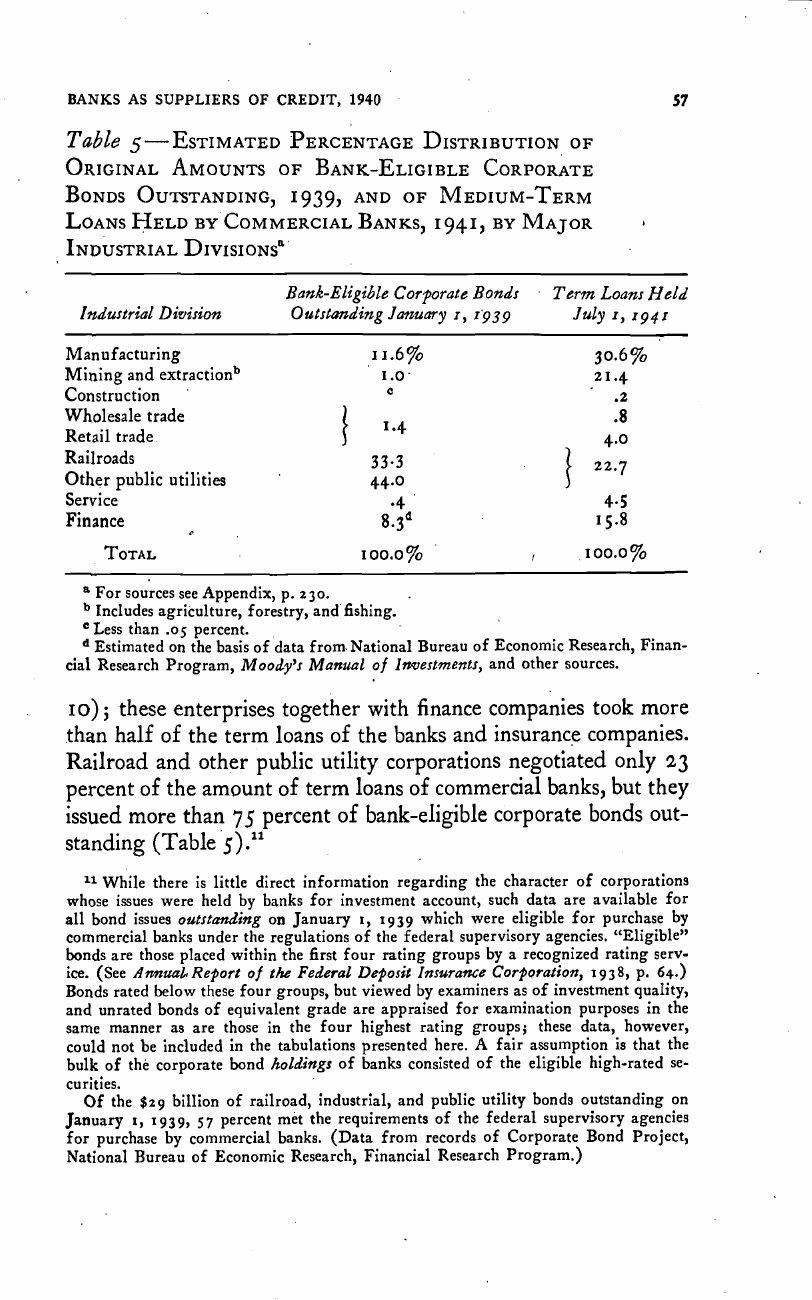
BANKS AS SUPPLIERS OF CREDIT, 1940
57
Table 5—ESTIMATED PERCENTAGE DISTRIBUTION OF
ORIGINAL AMOUNTS OF BANK-ELIGIBLE CORPORATE
BONDS
1939, AND OF MEDIUM-TERM
LOANS HELD BY COMMERCIAL BANKS, 1941, BY MAJOR
INDUSTRIAL DivIsIoNsa
Industrial Division
Bank-Eligible Corporate
Outstanding January r,
Bonds
1939
Te
rm Loans Held
July
Manufacturing
Mining and extractionb
ii.6%
1.0
30.6%
21.4
Construction
°
.2
Wholesale trade
Retail trade.
4
.
.8
4.0
Railroads
Other public utilities .
33.3 .
44.0
.
22.7
Service
.4
4.5
Finance
83d
. 15.8
TOTAL . ioo.o%
, .ioo.o%
a For
sources see Appendix, p. 230.
b Includes
agriculture, forestry, and fishing.
C
Less
than .05
percent.
d
Estimated on the basis of data from. National Bureau of Economic Research, Finan-
cial Research Program, Moody's Manual of investments, and other sources.
io); these enterprises together with finance companies took more
than half of the term loans of the banks and insurance companies.
Railroad and other public utility corporations negotiated only
percent of the amount of term loans of commercial banks, but they
issued more than 75 percent of bank-eligible corporate bonds out-
standing (Table
While
there is little direct information regarding the character of corporations
whose issues were held by banks for investment account, such data are available for
all bond issues outstanding on January i,
1939
which were eligible for purchase by
commercial banks under the regulations of the federal supervisory agencies. "Eligible"
bonds are those placed within the first four rating groups by a recognized rating serv-
ice. (See Annual.. Report of Me Federal Deposit Insurance Corporation, 1938, p. 64.)
Bonds rated below these four groups, but viewed by examiners as of investment quality,
and unrated bonds of equivalent grade are appraised for examination purposes in the
same manner as are those in the four highest rating groups; these data, however,
could not be included in the tabulations presented here. A fair assumption is that the
bulk of the corporate bond holdings of banks consisted of the eligible high-rated se-
curities.
Of the $29 billion of railroad, industrial, and public utility bonds outstanding on
January i,
1939,
57 percent met the requirements of the
federal supervisory agencies
for purchase by commercial banks. (Data from records of Corporate Bond Project,
National Bureau of Economic Research, Financial Research Program.)
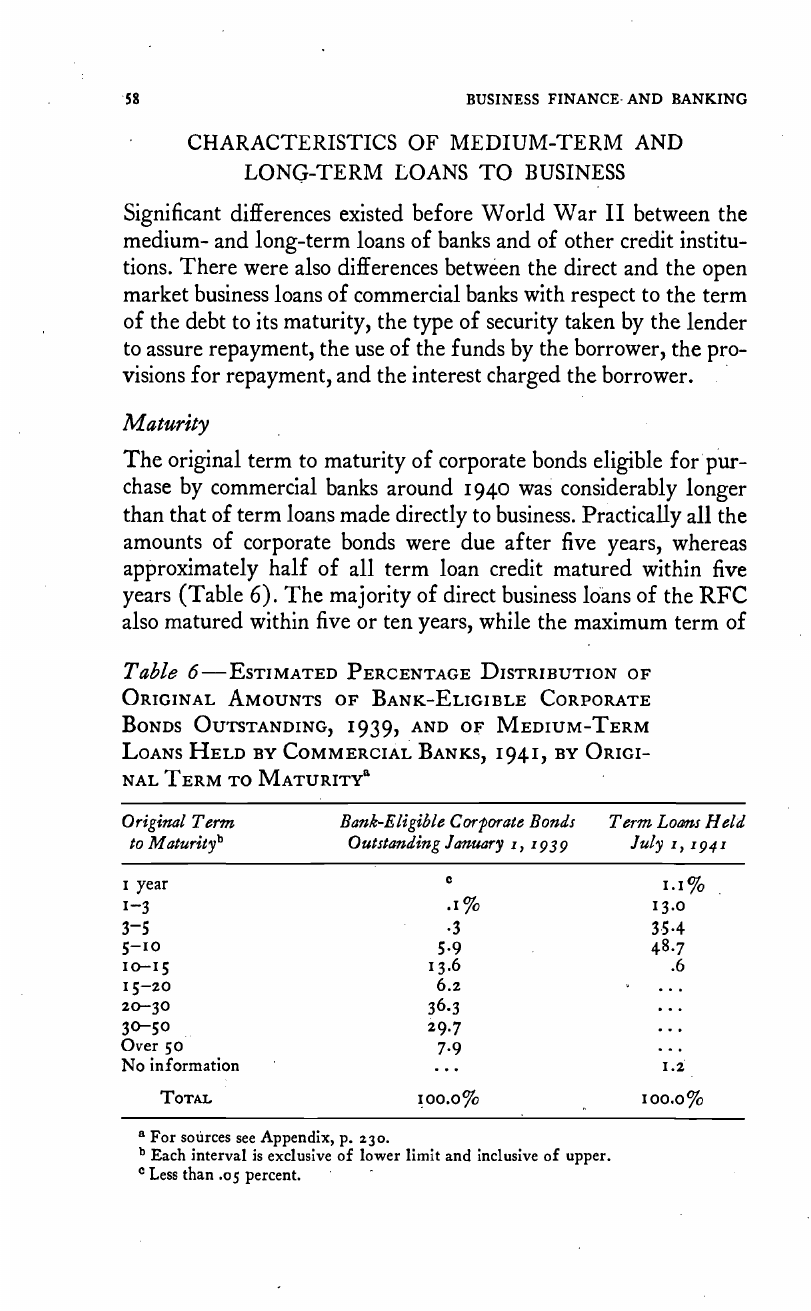
58
BUSINESS FINANCE- AND BANKING
• CHARACTERISTICS OF MEDIUM-TERM AND
LONG-TERM LOANS TO BUSINESS
Significant differences existed before World War II between the
medium- and long-term loans of banks and of other credit institu-
tions. There were also differences between the direct and the open
market business loans of commercial banks with respect to the term
of the debt to its maturity, the type of security taken by the lender
to assure repayment, the use of the funds by the borrower, the pro-
visions for repayment, and the interest charged the borrower.
Maturity
The original term to maturity of corporate bonds eligible forpur-
chase by commercial banks around 1940 was considerably longer
than that of term loans made directly to business. Practically all the
amounts of corporate bonds were due after five years, whereas
approximately half of all term loan credit matured within five
years (Table 6). The majority of direct business loans of the RFC
also matured within five or ten years, while the maximum term of
Table 6—ESTIMATED PERCENTAGE DISTRIBUTION OF
ORIGINAL AMOUNTS OF BANK-ELIGIBLE CORPORATE
BONDS OUTSTANDING, 1939, AND OF MEDIUM-TERM
LOANS HELD BY COMMERCIAL BANKS, 1941, BY ORIGI-
NAL TERM TO MATURITYa
Original Term
to Maturityb
Bank-Eligible Corporate
Outstanding January i,
Bonds
1939
Term Lo€ms Held
July 1,194
I year
°
1.1%
1—3 .i% 13.0
3—5
.3 3.5.4
5—10
5.9
48.7
10—15 13.6
.6
15—20
6.z ..
2O—30 36.3 .
30—50 29.7 ...
Over 50
7.9 .•
No information
... 1.2
TOTAL
ioo.o%
a For
sources see Appendix, p. 230.
b
Each interval is exclusive of lower limit and inclusive of upper.
C
Less
than .05
percent. -
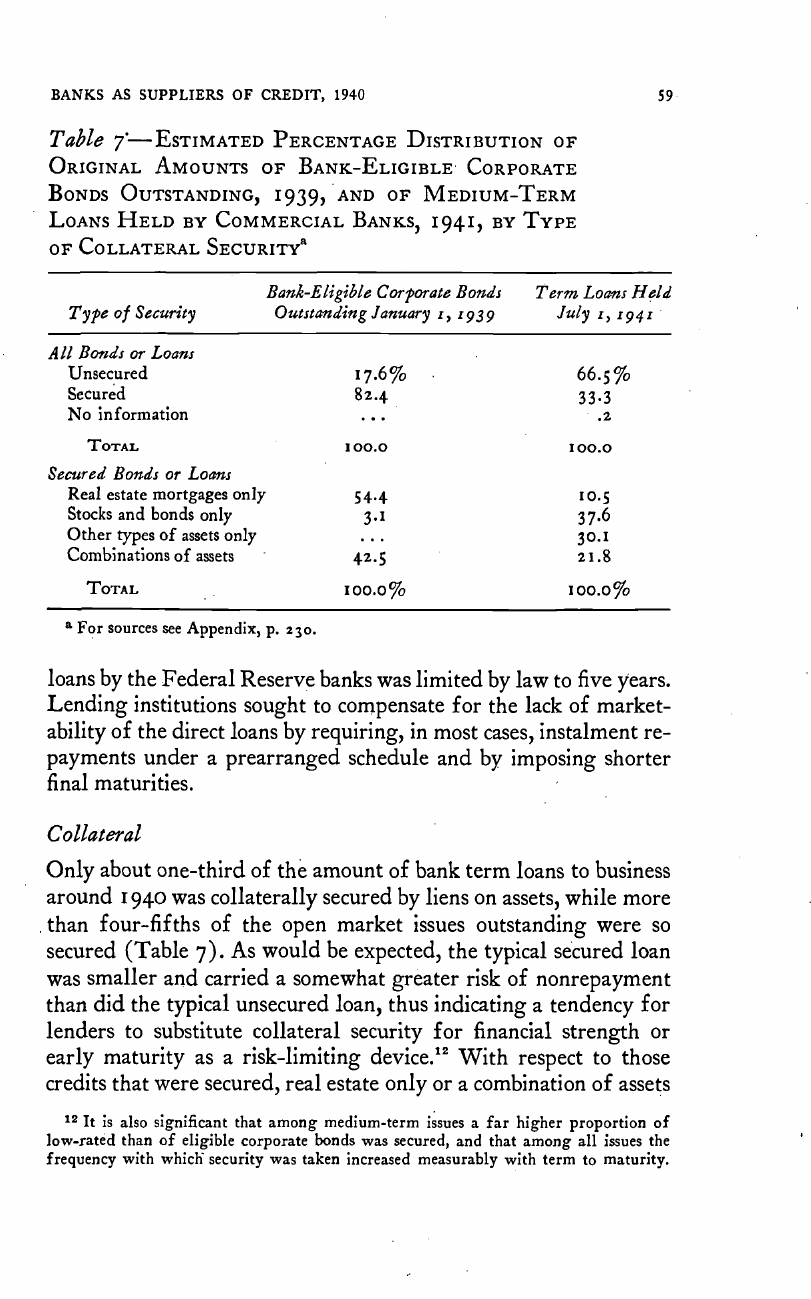
BANKS AS SUPPLIERS OF CREDIT, 1940
59
Table 7—ESTIMATED PERCENTAGE DISTRIBUTION OF
ORIGINAL AMOUNTS OF BANK-ELIGIBLE CORPORATE
BONDS OUTSTANDING, 1939, AND OF MEDIUM-TERM
LOANS HELD BY COMMERCIAL BANKS, 1941, BY TYPE
OF COLLATERAL
Type of Security
Bank-Eligible Corporate
Outstanding January i,
Bonds
1939
Term Loans Held
July 1,1941
All Bonds or Loans
Unsecured
Secured
No information
17.6%
82.4
..
.
.
:
33.3
.2
TOTAL
100.0
100.0
Secured Bonds or Loans
Real estate mortgages only
Stocks and bonds only
Other types of assets oniy
Combinations of assets
54.4
3'
. .
.
42.5
•
10.5
37.6
30.1
zi.8
TOTAL
ioo.o%
ioo.o%
a For
sources see Appendix, p. 230.
loans by the Federal Reserve banks was limited by law to five years.
Lending institutions sought to compensate for the lack of market-
ability of the direct loans by requiring, in most cases, instalment re-
payments under a prearranged schedule and by imposing shorter
final maturities.
Collateral
Only about one-third of the amount of bank term loans to business
around 1940 was collaterally secured by liens on assets, while more
than four-fifths of the open market issues outstanding were so
secured (Table 7). As would be expected, the typical secured loan
was smaller and carried a somewhat greater risk of nonrepayment
than did the typical unsecured loan, thus indicating a tendency for
lenders to substitute collateral security for financial strength or
early maturity as a risk-limiting device.12 With respect to those
credits that were secured, real estate only or a combination of assets
12 It is also significant that among medium-term issues a far higher proportion of
low-rated than of eligible corporate bonds was secured, and that among all issues the
frequency with which security was taken increased measurably with term to maturity.
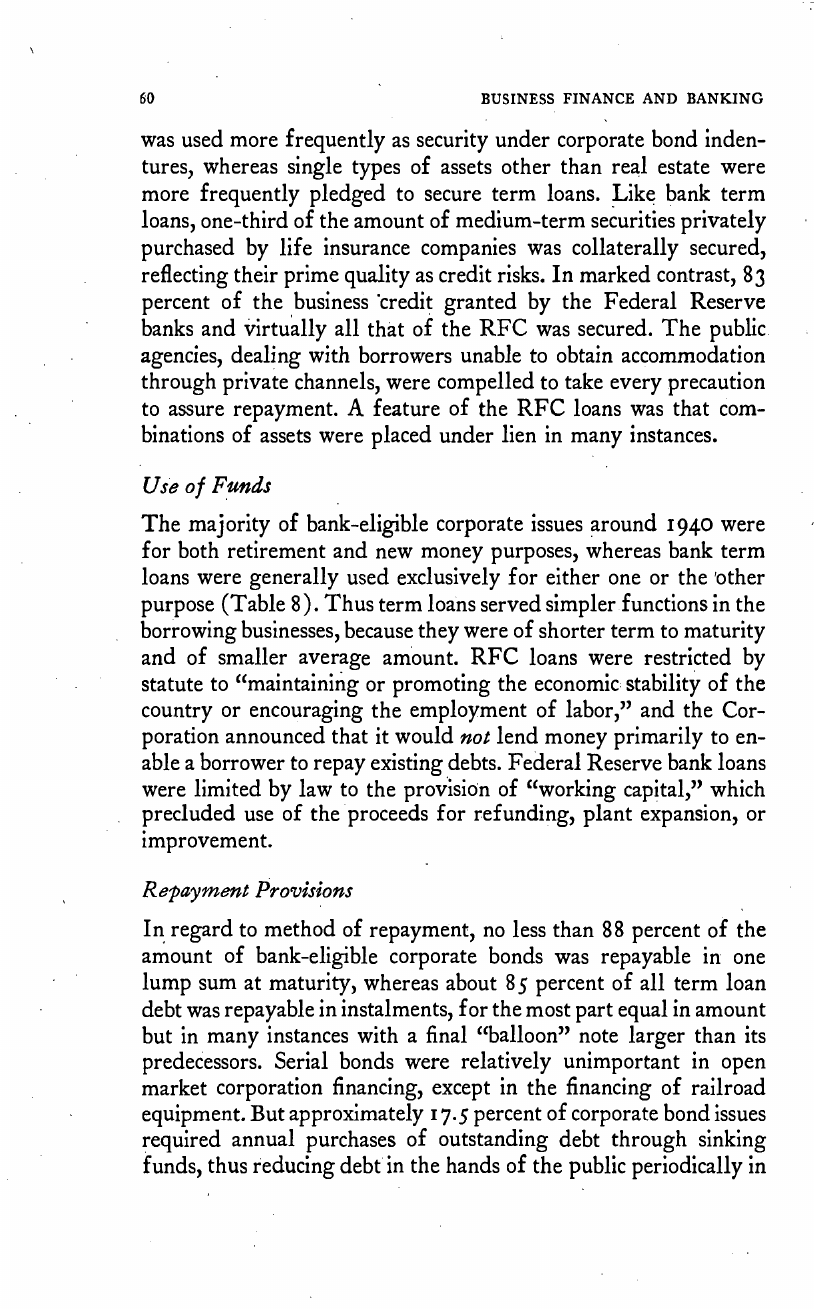
60 BUSINESS FINANCE AND BANKING
was used more frequently as security under corporate bond inden-
tures, whereas single types of assets other than real estate were
more frequently pledged to secure term loans. Like bank term
loans, one-third of the amount of medium-term securities privately
purchased by life insurance companies was collaterally secured,
reflecting their prime quality as credit risks. In marked contrast, 83
percent of the business credit granted by the Federal Reserve
banks and virtually all that of the RFC was secured. The
agencies, dealing with borrowers unable to obtain accommodation
through private channels, were compelled to take every precaution
to assure repayment. A feature of the RFC loans was that com-
binations of assets were placed under lien in many instances.
Use of Fzinds
The majority of bank-eligible corporate issues around 1940 were
for both retirement and new money purposes, whereas bank term
loans were generally used exclusively for either one or the other
purpose (Table 8). Thus term loans served simplerfunctions in the
borrowing businesses, because they were of shorter term to maturity
and of smaller average amount. RFC loans were restricted by
statute to "maintaining or promoting the economic stability of the
country or encouraging the employment of labor," and the Cor-
poration announced that it would not lend money primarily to en-
able a borrower to repay existing debts. Federal Reserve bank loans
were limited by law to the provision of "working capital," which
precluded use of the proceeds for refunding, plant expansion, or
improvement.
Repayment Provisions
In regard to method of repayment, no less than 88 percent of the
amount of bank-eligible corporate bonds was repayable in one
lump sum at maturity, whereas about 85 percent of all term loan
debt was repayable in instalments, for the most part equal in amount
but in many instances with a final "balloon" note larger than its
predecessors. Serial bonds were relatively unimportant in open
market corporation financing, except in the financing of railroad
equipment. But approximately 17.5 percent of corporate bond issues
required annual purchases of outstanding debt through sinking
funds, thus reducing debt in the hands of the public periodically in
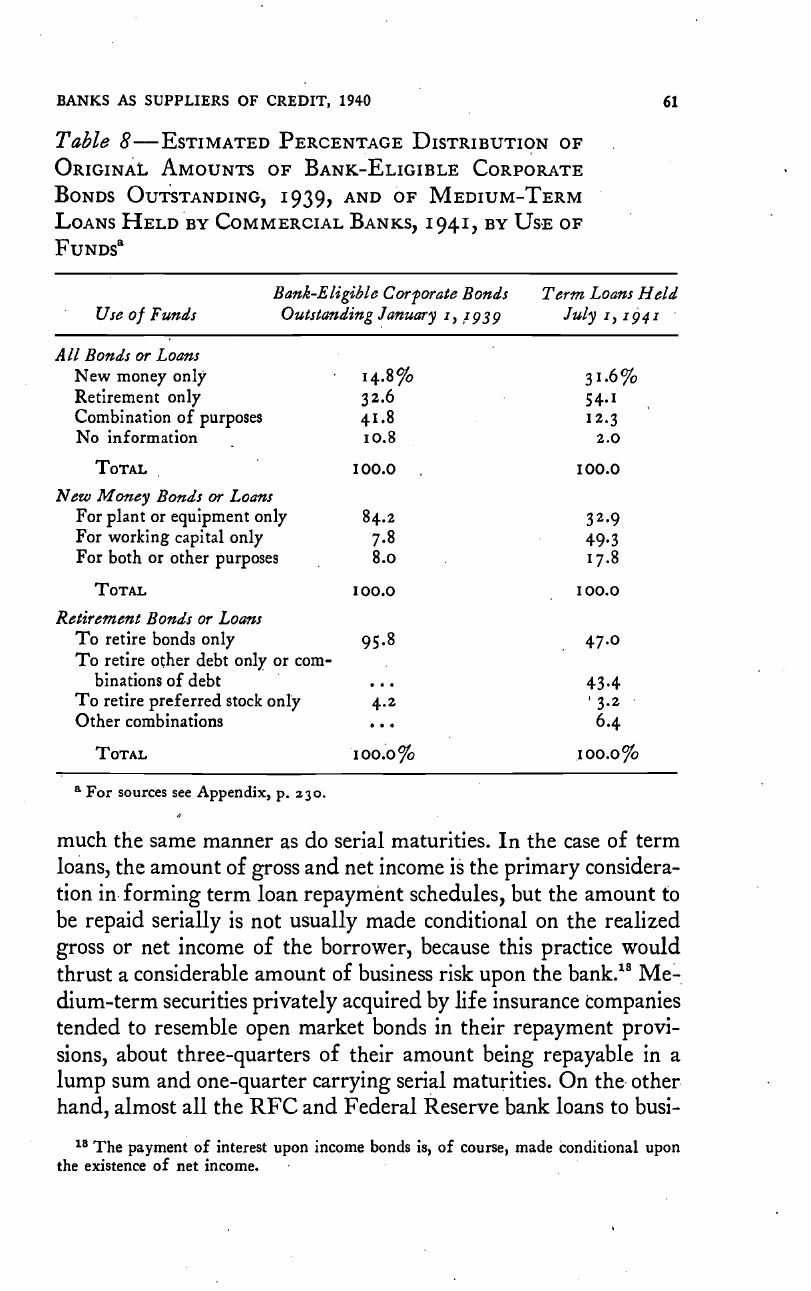
BANKS AS SUPPLIERS OF CREDIT, 1940
61
Table 8—ESTIMATED PERCENTAGE DISTRIBUTION OF
ORIGINAL AMOUNTS OF BANK-ELIGIBLE CORPORATE
BONDS OUTSTANDING, 1939, AND OF MEDIUM-TERM
LOANS HELD BY COMMERCIAL BANKS, 1941, BY OF
FUNDSa
Bank-Eligible Corpora
Use of Funds
Outstanding January
te Bonds
1939
T
erm Loans He
July z,
id
•
All Bonds orLoans
0
New money only 14.8% 31.6%
Retirement only 32.6
Combination of purposes 41.8 .
54.1
I 2.3
No information io.8 2.0-
TOTAL 100.0 100.0
New Money Bonds or Loans
For plant or equipment only 84.2
32.9
For working capital only
7.8
49.3
For both or other purposes
8.o
. 17.8
TOTAL
100.0
100.0
Retirement Bonds or Loans
To retire bonds oniy
95.8 47.0
To retire other debt only or corn-
binations of debt
... 43.4
To retire preferred stock only 4.2
3.2
Other combinations
... 6.4
TOTAL
ioo.o%
.ioo.o%
a For sources see Appendix,
230.
0
much
the same manner as do serial maturities. In the case of term
loans, the amount of gross and net income is the primary considera-.
tion in forming term loan repayment schedules, but the amount to
be repaid serially is not usually made conditional on the realized
gross or net income of the borrower, because this practice would
thrust a considerable amount of business risk upon the bank.13 Me-.
dium-term securities privately acquired by life insurance companies
tended to resemble open market bonds in their repayment provi-
sions, about three-quarters of their amount being repayable in a
lump sum and one-quarter carrying serial maturities. On the other
hand, almost all the RFC and Federal Reserve bank loans to busi-
The payment of interest upon income bonds is, of course, made conditional upon
the existence of net income.
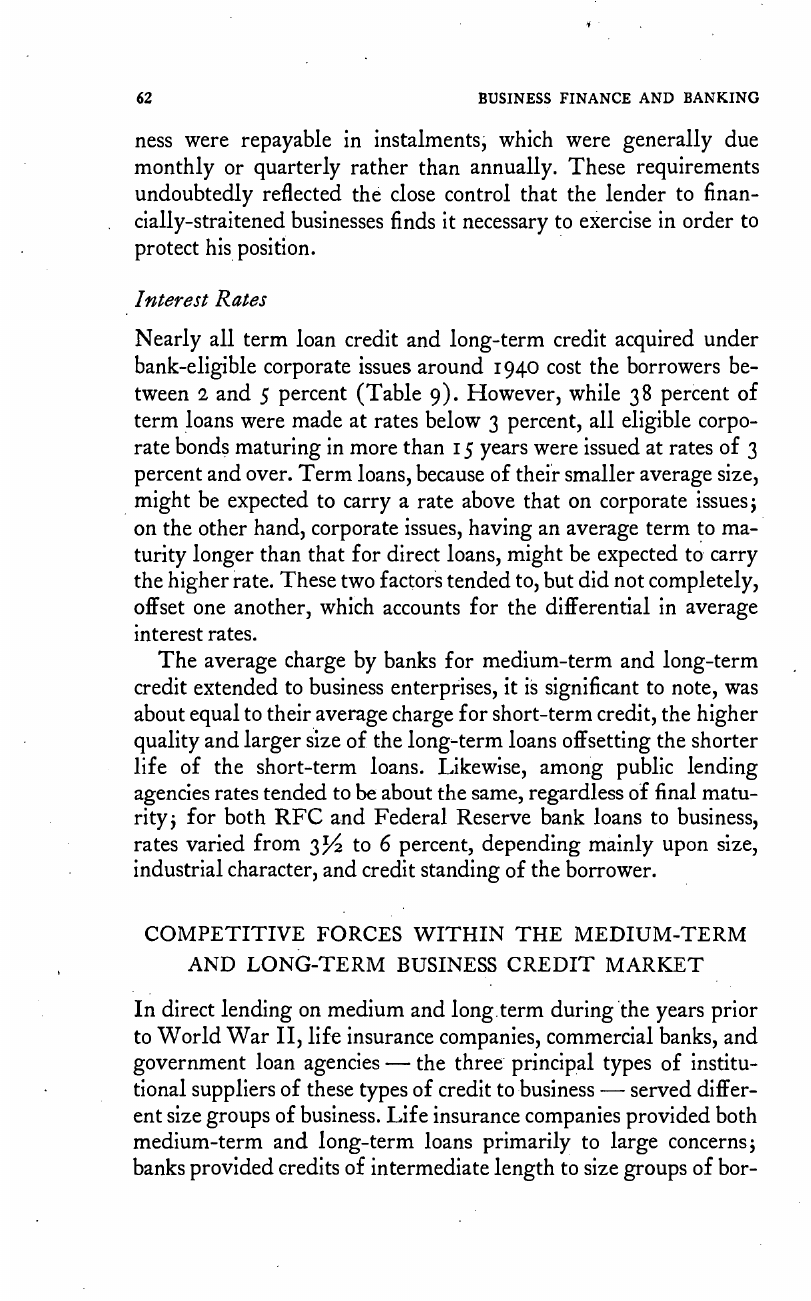
62
BUSINESS FINANCE AND BANKING
ness were repayable in instalments, which were generally due
monthly or quarterly rather than annually. These requirements
undoubtedly reflected the close control that the lender to finan-
cially-straitened businesses finds it necessary to exercise in order to
protect his, position.
Interest Rates
Nearly all term loan credit and long-term credit acquired under
bank-eligible corporate issues around 1940 cost the borrowers be-
tween 2 and c percent (Table 9). However, while 38 percent of
term loans were made at rates below 3 percent, all eligible corpo-
rate bonds maturing in more than ig years were issued at rates of 3
percent and over. Term loans, because of their smaller average size,
might be expected to carry a rate above that on corporate issues;
on the other hand, corporate issues, having an average term to ma-
turity longer than that for direct loans, might be expected to' carry
the higher rate. These two factors tended to, but did not completely,
offset one another, which accounts for the differential in average
interest rates.
The average charge by banks for medium-term and long-term
credit extended to business enterprises, it is significant to note, was
about equal to their average charge for short-term credit, the higher
quality and larger size of the long-term loans offsetting the shorter
life of the short-term loans. Likewise, among public lending
agencies rates tended to be about the same, regardless of final matu-
rity; for both RFC and Federal Reserve bank loans to business,
rates varied from
to
6 percent, depending mainly upon size,
industrial character, and credit standing of the borrower.
COMPETITIVE FORCES WITHIN THE MEDIUM-TERM
AND LONG-TERM BUSINESS CREDIT MARKET
In direct lending on medium and long.term during 'the years prior
to World War II, life insurance companies, commercial banks, and
government loan agencies —
the three principal types of institu-
tional suppliers of these types of credit to business —
served differ-
ent size groups of business. Life insurance companies provided both
medium-term and long-term loans primarily to large concerns;
banks provided credits of intermediate length to size groups of bor-
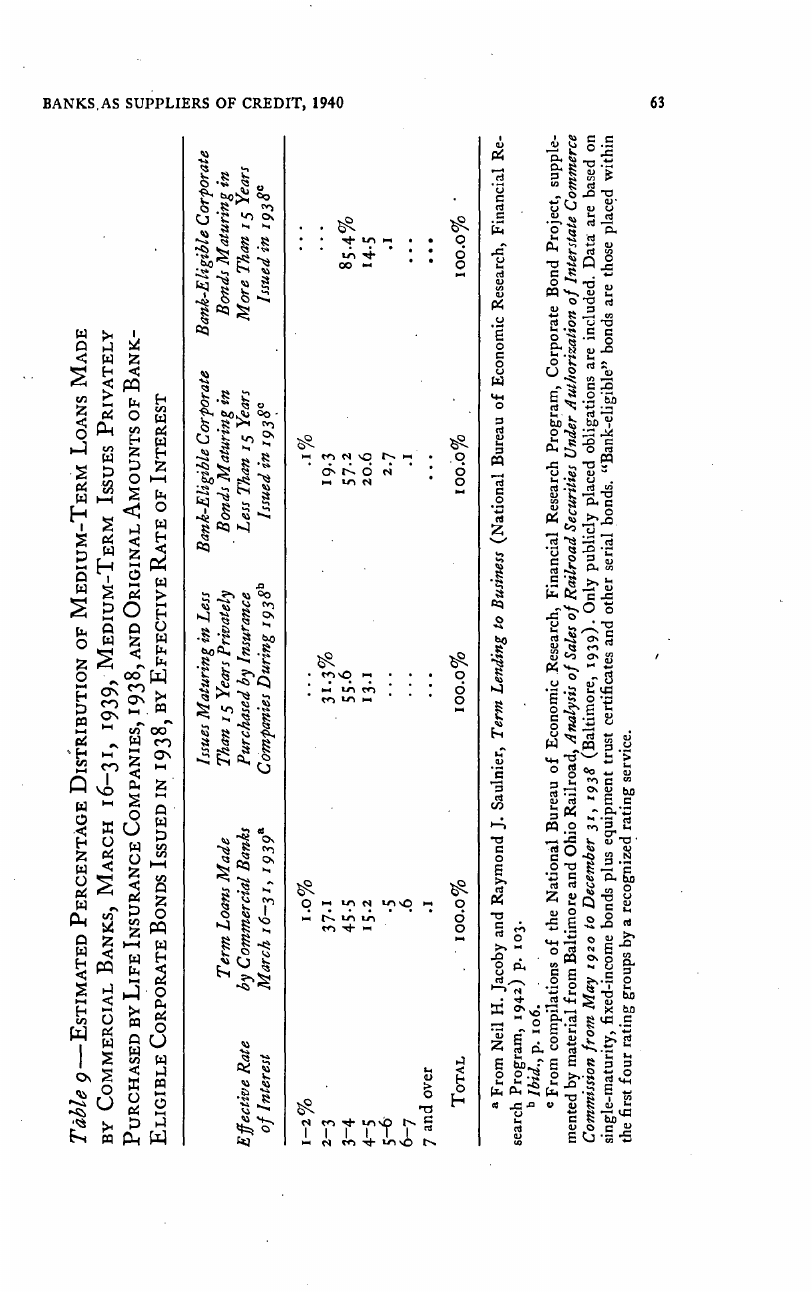
Issues Maturing in Less
Bank-Eligible Corporate
Bank-Eligible Corporate
Term Loans Made
Than 15
Years Privately
Bonds Maturing in
Bonds Maturing in
Effective Rate by Commercial Banks
Purchased by Insurance
Less Than Years
More Than 15
Years
of Interest March 16—31, 59395
Companies During
Issued in
Issued
1938C
5—2% i.o% ...
.i% ...
2—3 37.1
31.3% 19.3 .
3—4 45.5
55.6
57.2
85.4%
4—5
55.2 13.1 20.6
'4.5
5—6
.5 . .
.
2.7 .1
6—7
.6 ...
.1 ...
7andover
.1 ...
... ...
TOTAL ioo.o% ioo.o% ioo.o% - ioo.o%
a From
Neil H. Jacoby and Raymond J. Saulnier, Term Lending to Business (National Bureau of Economic Research, Financial Re-
search Program, 5942)
p.
103.
blbjd.,p.
io6.
From compilations of the National Bureau of Economic Research, Financial Research Program, Corporate Bond Project, supple-
mented by material from Baltimore and Ohio Railroad, Analysis of Sales of Railroad Securities Under Authorization of Interstate Commerce
Commission from May 1920 to December 31,
5938
(Baltimore, 1939). Only publicly placed obligations are included. Data are based on
single-maturity, fixed-income bonds plus equipment trust certificates and other serial bonds. "Bank-eligible" bonds are those placed within
the first four rating groups by a recognized rating service.
Table 9—ESTIMATED PERCENTAGE OF MEDIUM-TERM LOANS MADE
BY COMMERCIAL BANKS, MARCH 16—31, 1939, MEDIUM-TERM ISSUES PRIVATELY
PURCHASED BY LIFE INSURANCE COMPANIES, 1938, AND ORIGINAL AMOUNTS OF BANK-
ELIGIBLE CORPORATE BONDS ISSUED IN 1938, BY EFFECTIVE RATE OF INTEREST
z
In
In
'0.
'0
In
0
'TJ
'C
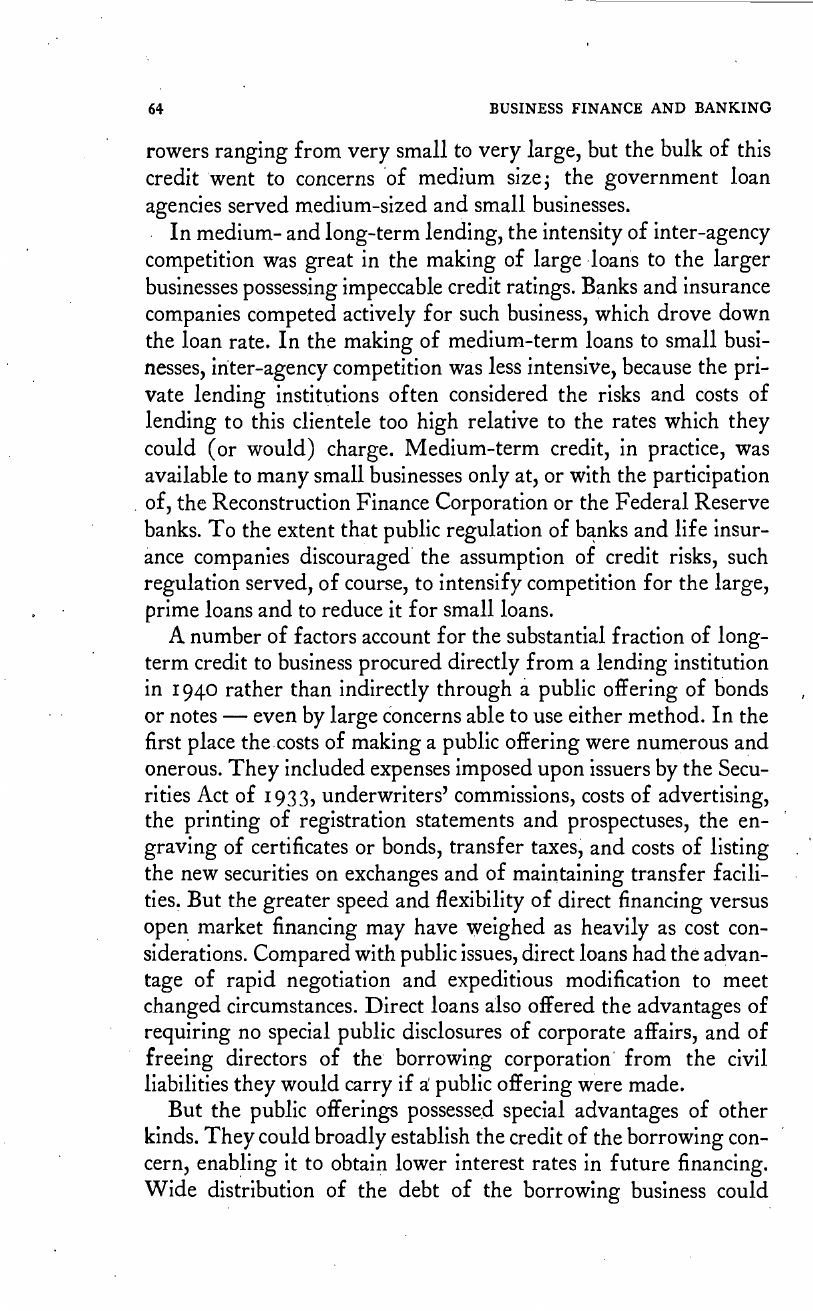
64
BUSINESS FINANCE AND BANKING
rowers ranging from very small to very large, but the bulk of this
credit went to concerns of medium size; the government loan
agencies served medium-sized and small businesses.
In medium- and long-term lending, the intensity of inter-agency
competition was great in the making of large loans to the larger
businesses possessing impeccable credit ratings. Banks and insurance
companies competed actively for such business, which drove down
the loan rate. In the making of medium-term loans to small busi-
nesses, inter-agency competition was less intensive, because the pri-
vate lending institutions often considered the risks and costs of
lending to this clientele too high relative to the rates which they
could (or would) charge. Medium-term credit, in practice, was
available to many small businesses only at, or with the participation
of, the Reconstruction Finance Corporation or the Federal Reserve
banks. To the extent that public regulation of banks and life insur-
ance companies discouraged the assumption of credit risks, such
regulation served, of course, to intensify competition for the large,
prime loans and to reduce it for small loans.
A number of factors account for the substantial fraction of long-
term credit to business procured directly from a lending institution
in 1940 rather than indirectly through a public offering of bonds
or notes —
even by large concerns able to use either method. In the
first place the costs of making a public offering were numerous and
onerous. They included expenses imposed upon issuers by the Secu-
rities Act of 1933, underwriters' commissions, costs of advertising,
the printing of registration statements and prospectuses, the en-
graving of certificates or bonds, transfer taxes, and costs of listing
the new securities on exchanges and of maintaining transfer facili-
ties. But the greater speed and flexibility of direct financing versus
open market financing may have weighed as heavily as cost con-
siderations. Compared with public issues, direct loans had the advan-
tage of rapid negotiation and expeditious modification to meet
changed circumstances. Direct loans also offered the advantages of
requiring no special public disclosures of corporate affairs, and of
freeing directors of the borrowing corporation from the civil
liabilities they would carry if
public offering were made.
But the public offerings possessed special advantages of other
kinds. They could broadly establish the credit of the borrowing con-
cern, enabling it to obtain lower interest rates in future financing.
Wide distribution of the debt of the borrowing business could
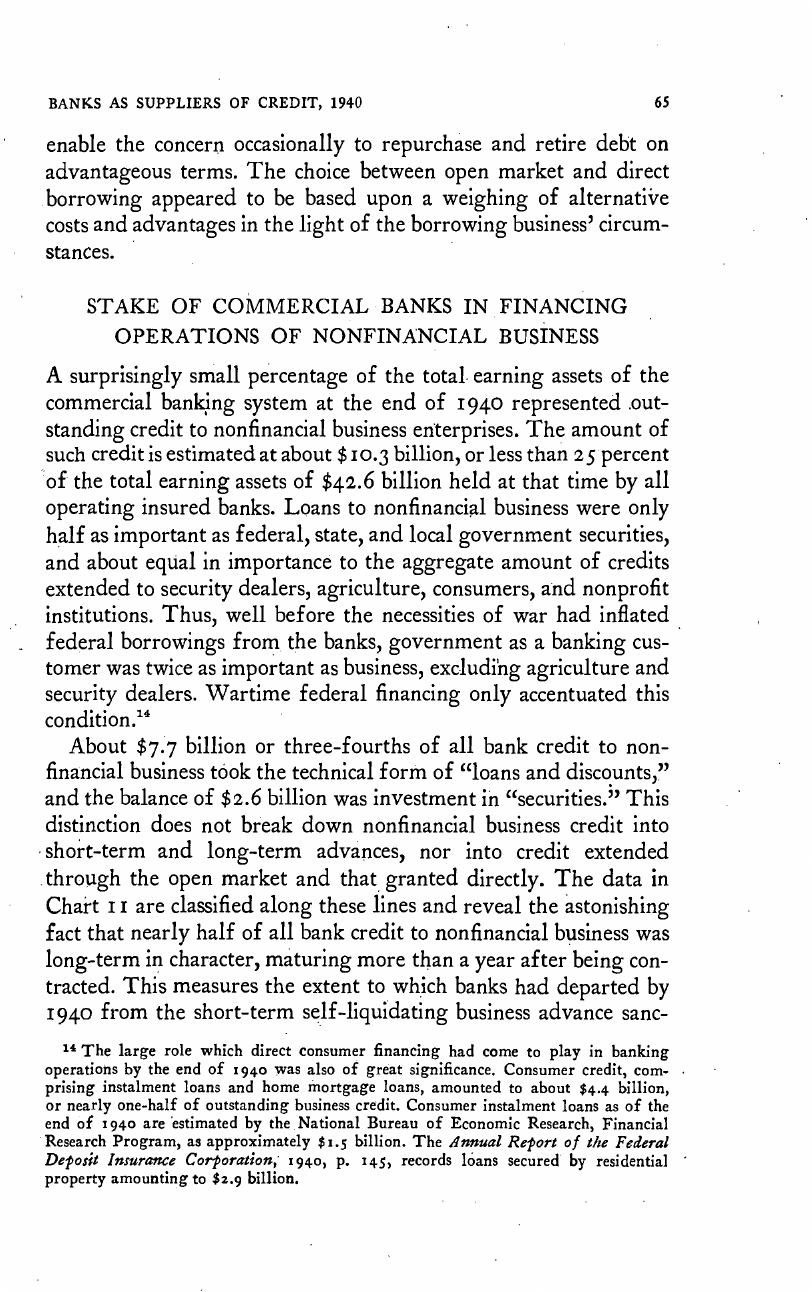
BANKS AS SUPPLIERS OF CREDIT, 1940
65
enable the concern occasionally to repurchase and retire debt on
advantageous terms. The choice between open market and direct
borrowing appeared to be based upon a weighing of alternative
costs and advantages in the light of the borrowing business' circum-
stances.
STAKE OF COMMERCIAL BANKS IN FINANCING
OPERATIONS OF NONFINANCIAL BUSINESS
A surprisingly small percentage of the total. earning assets of the
commercial banking system at the end of 1940 represented out-
standing credit to nonfinancial business enterprises. The amount of
such credit is estimated at about $10.3 billion, or less than 25percent
of the total earning assets of
billion held at that time by all
operating insured banks. Loans to nonfinancial business were only
half as important as federal, state, and local government securities,
and about equal in importance to the aggregate amount of credits
extendel to security dealers, agriculture, consumers, and nonprofit
institutions. Thus, well before the necessities of war had inflated
federal borrowings from, the banks, government as a banking cus-
tomer was twice as important as business,
agriculture and
security dealers. Wartime federal financing only accentuated this
condition.14
About $7.7 billion or three-fourths of all bank credit to non-
financial business took the technical form of "loans and discounts,"
and the balance of $2.6 billion was investment in C(securities " This
distinction does not break down nonfinancial business credit into
short-term and long-term advances, nor into credit extended
through the open market and that granted directly. The data in
Chart I I are classified along these lines and reveal the astonishing
fact that nearly half of all bank credit to nonfinancial business was
long-term in character, maturing more than a year after being con-
tracted. This measures the extent to which banks had departed by
1940 from the short-term self-liquIdating business advance sanc-
14 The large role which direct consumer financing had come to play in banking
operations by the end of 1940 was also of great significance. Consumer credit, com-
prising instalment loans arid home mortgage loans, amounted to about
billion,
or nearly one-half of outstanding business credit. Consumer instalment loans as of the
end of 1940 are estimated by the ,National Bureau of Economic Research, Financial
Research Program, as approximately
billion. The Annual Report of the Federal
Deposit Insurance Corporation, 1940, p.
145, records loans secured' by residential
property amounting to $2.9 billion.
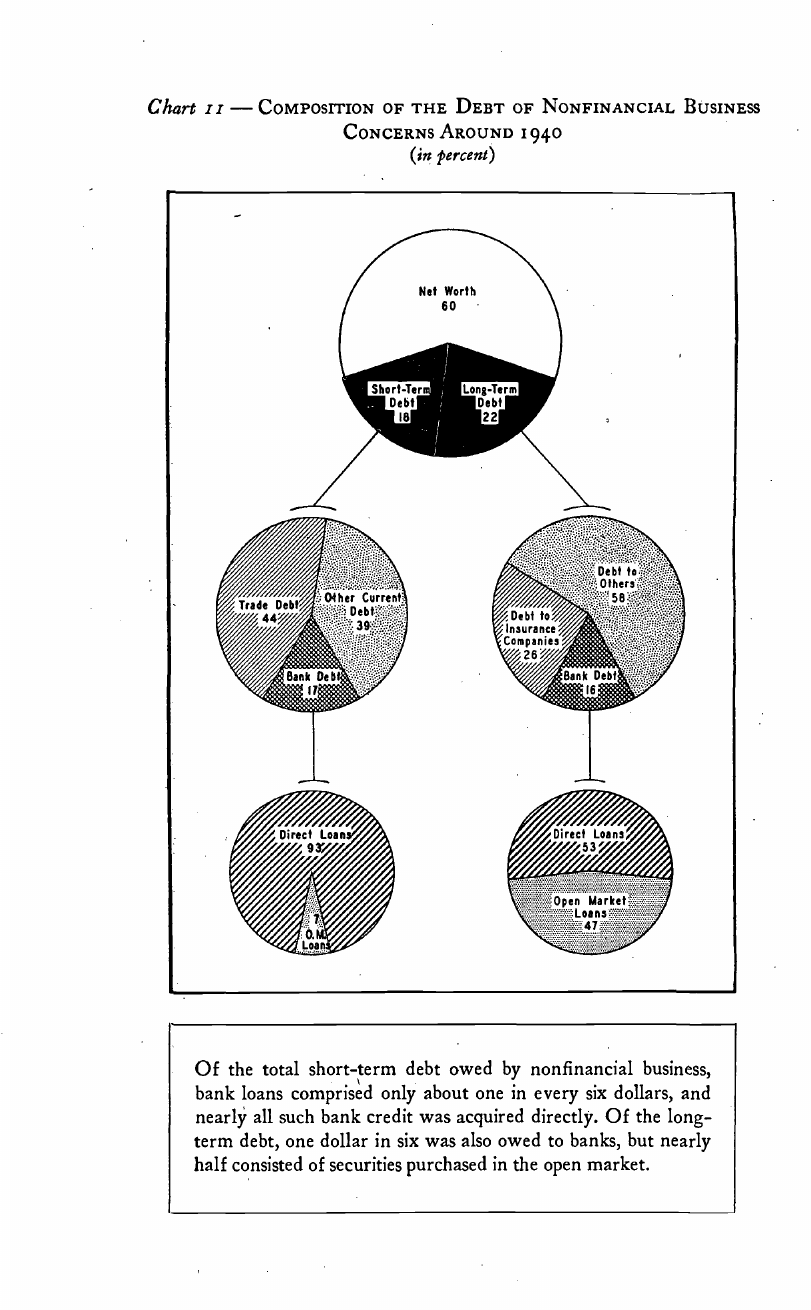
Chart ii — CoMPosrrloN
OF THE DEBT OF NONFINANCIAL BUSINESS
CONCERNS AROUND 1940
percent)
Of the total short-term debt owed by nonfinancial business,
bank loans comprised only about one in every six dollars, and
nearly all such bank credit was acquired directly. Of the long-
term debt, one dollar in six was also owed to banks, but nearly
half consisted of securities purchased in the open market.
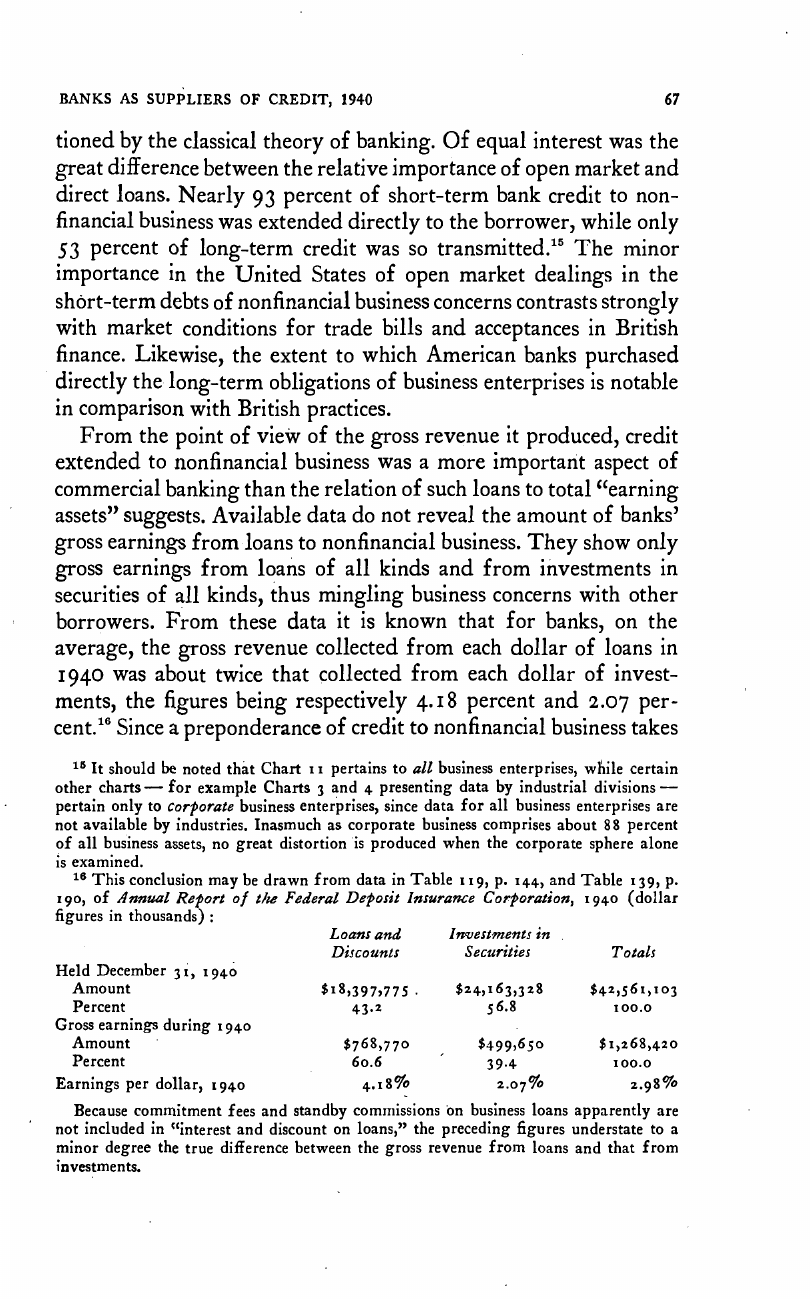
BANKS AS SUPPLIERS OF CREDIT, 1940
67
tioned by the classical theory of banking. Of equal interest was the
great difference between the relative importance of open market and
direct loans. Nearly
93 percent of short-term bank credit to non-
financial business was extended directly to the borrower, while only
53
percent
of long-term credit was so transmitted.15 The minor
importance in the United States of open market dealings in the
short-term debts of nonfinancial business concerns contrasts strongly
with market conditions for trade bills and acceptances in British
finance. Likewise, the extent to which American banks purchased
directly the long-term obligations of business enterprises is notable
in comparison with British practices.
From the point of view of the gross revenue it produced, credit
extended to nonfinancial business was a more important aspect of
commercial banking than the relation of such loans to total Ccearning
assets" suggests. Available data do not reveal the amount of banks'
gross earnings from loans to nonfinancial business. They show only
gross earnings from loans of all kinds and from investments in
securities of all kinds, thus mingling business concerns with other
borrowers. From these data it is known that for banks, on the
average, the gross revenue collected from each dollar of loans in
1940 was about twice that collected from each dollar of invest-
ments, the figures being respectively 4.18
percent
and 2.07 per-
cent.'6 Since a preponderance of credit to nonfinancial business takes
It should be noted that Chart i i pertains to all business enterprises, while certain
other charts — for
example Charts 3 and 4 presenting data by industrial divisions —
pertain
only to cor/'orate business enterprises, since data for all business enterprises are
not available by industries. Inasmuch as corporate business comprises about 88 percent
of all business assets, no great distortion is produced when the corporate sphere alone
is examined.
16
This conclusion may be drawn from data in Table 119,
p.
144, and Table i
39,
p.
I 90, of Annual Report of the Federal Deposit Insurarwe Corporation, 1940 (dollar
figures in thousands):
Loans and
Investments in
Disco unis
Securities Totals
Held December 31,
1940
Amount
$18,397,775 .
$24,163,328
$42,561,103
Percent
43.2
too.o
Gross earnings during 1940
Amount
$768,770 $499,650 $1,268,420
Percent 6o.6
39.4
100.0
Earnings per dollar, 194o 4.18%
2.07%
2.98%
Because commitment fees and standby commissions on business loans apparently are
not included in "interest and discount on loans," the preceding figures understate to a
minor degree the true difference between the gross revenue from loans and that from
investments.
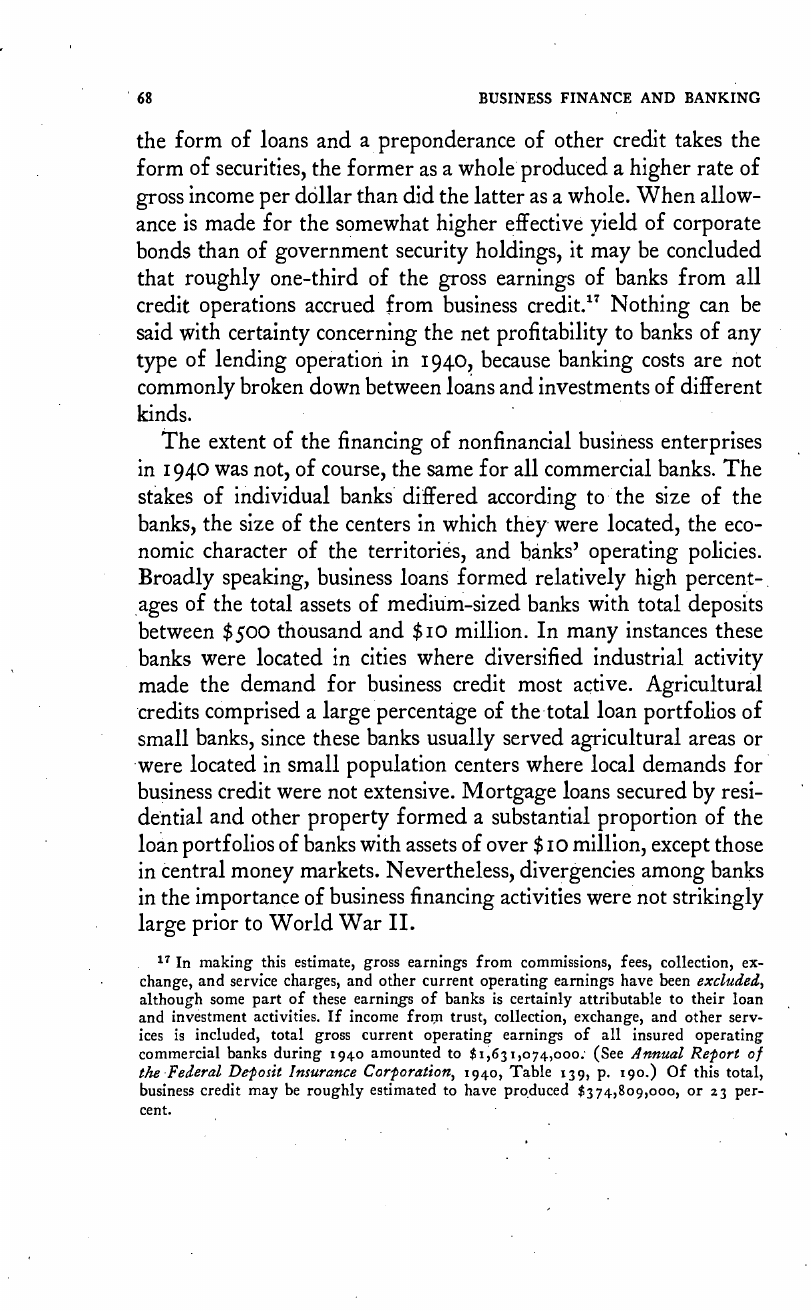
68
BUSINESS FINANCE AND BANKING
the form of loans and a preponderance of other credit takes the
form of securities, the former as a whole produced a higher rate of
gross income per dollar than did the latter as a whole. When allow-
ance is made for the somewhat higher effective yield of corporate
bonds than of government security holdings, it may be concluded
that roughly one-third of the gross earnings of banks from all
credit operations accrued from business credit.17 Nothing can be
said with certainty concerning the net profitability to banks of any
type of lending operation in 1940, because banking costs are not
commonly broken down between loans and investments of different
kinds.
The extent of the financing of nonfinancial business enterprises
in 1940 was not, of course, the same for all commercial banks. The
stakes of individual banks differed according to: the size of the
banks, the size of the centers in which they were located, the eco-
nomic character of the territories, and banks' operating policies.
Broadly speaking, business loans formed relatively high percent-
ages of the total assets of medium-sized banks with total deposits
between $500 thousand and $io million. In many instances these
banks were located in cities where diversified industrial activity
made the demand for business credit most active. Agricultural
credits comprised a large percentage of the total loan portfolios of
small banks, since these banks usually served agricultural areas or
were located in small population centers where local demands for
business credit were not extensive. Mortgage loans secured by resi-
dential and other property formed a substantial proportion of the
loan portfolios of banks with assets of over $10 million, except those
in central money markets. Nevertheless, divergencies among banks
in the importance of business financing activities were not strikingly
large prior to World War II.
1? In making this estimate, gross earnings from commissions, fees, collection, ex-
change, and service charges, and other current operating earnings have been excluded,
although some part of these earnings of banks is certainly attributable to their loan
and investment activities. If income trust, collection, exchange, and other serv-
ices
is
included, total gross current operating earnings of all insured operating
commercial banks during 1940 amounted to $1,631,074,000. (See Annual Report of
the Federal Deposit Insurance Corporation, i94o, Table 139, p. '9°.) Of this total,
business credit may be roughly estimated to have produced $374,809,000, or 23 per-
cent.
